Eightball #1-23 by Daniel Clowes.
I was very curious about how re-reading Eightball would feel like. I read Clowes’ latest (very acclaimed) book Patience a few months back, and I thought it was crap. (There. I’ve now statistically alienated about 97% of potential readers of this blog article.) It was so bad that it started me wondering whether perhaps nothing Clowes had ever done had ever been any good.
Was Clowes nothing more than an empty stylist, and (these days) not a very good stylist, either?
Let’s read and find out!
By the time Eightball started, Clowes had been publishing for quite a while, but with little real commercial (or critical, I think) success. He’d done seven issues of Lloyd Llewellyn, a sorta-kinda spoof of 50s detective movies, and they were OK, but didn’t really prepare us for…
Suddenly the artwork is assured instead of tentative, and seems to have hidden depths. Instead of a jokey semi parody, the story feels like the genuine deal, and is shocking and mysterious.
The storytelling is also way more complex than earlier. It skips around, confidently, temporally and spatially without explicitly explaining what’s going on, but it reads extremely well. There’s no doubt what’s going on in this silent page.
As I remember it, the main serial (Like a Velvet Glove Cast in Iron) was an immediate success. It’s what the word “Lynchian” was made to describe, perhaps, meaning that it was perfect for its time, what with Twin Peaks being shown on TV the year after.
It’s terrific. You feel that there is some meaning to the mysteries presented; that there’s something worth paying attention to and to dig into.
Lloyd Llewellyn had also been an anthology, but there the bulk of the stories had concerned Llewellyn in one way or another. Eightball is a much more free-wheeling one-person anthology. Clowes is doing whatever he wants to, so in the first issue he also does a parody of Jack Chick-like horror stories about satanists and their metal music…
Llewellyn also shows up for some short stories in the first few issues, but he’s soon left by the wayside.
But most of the non-Velvet Glove bits of the comic book deal with either the comic book business (as in this intro to what will be the story of Dan Pussey, a super-hero comic book penciller), and rants from Clowes about how much people and things suck (that guy up there, bugging Clowes, certainly sucks).
That does look slightly like an art spiegelman send-up, doesn’t it? Yes, Clowes thinks he sucks, too. Or at least is annoying.
Back to the main feature: I remember loving Velvet Glove when I read it back then, and I loved it this time too, but this time it seems more apparent to me that Clowes didn’t really know where it was going. It goes from random thing to random thing apparently associatively, and while the mood is mysterious and sombre, Clowes can’t resist dropping jokes into the storyline.
In the Pussey storyline, Pussey tries breaking into the art comics crowd, here exemplified by “Emperor’s New Clothes” with hand-torn pages (a reference to Françoise Mouly and Art Spiegelman’s Raw anthology), and here’s Spiegelman again:
Fantagraphics publisher Gary Groth (with the Hernandez brothers) also are also in for some ribbing:
Yes… them Mexicans and their bathroom tiling… The humour in some of these pieces feels somewhat lazy.
Another constant presence in the early issues of Eightball are adaptations of stories from Duplex Planet (David Greenberger’s long running project to document stuff old people say), which was later made into its own comic book.
With issue five, it’s obvious we have a hit on our hands. All the issues have gone into second printings, and Fantagraphics starts printing Eightball on white, shiny paper (with partial interior colours). Just a couple of years earlier, the planned Lloyd Llewellyn colour special had been printed in black and white due to low demand, but now: No expenses spared.
The white, shiny paper does work great with Clowes’ artwork. The blacks are so much blacker. Juicy black black which makes the artwork even more stylish, and perhaps take on a sheen of the supernatural perfection of Charles Burns.
I think this letter writer expresses the general critical consensus. It’s hip! It’s weird! It’s a success!
Exactly.
The last major strain of stories here is Clowes depicting himself out and about in the world, thinking about things and thinking about himself. He’s quite annoyed with everything. It’s amusing and very self-conscious: He knows he’s making himself look like an asshole, but he hopes we’ll be sympathetic anyway.
This is the exact spot in Velvet Glove where I lost faith in the narrative. Yes, it’s a story filled with strange happenings, but if we’re to care enough to unravel the complex interactions, we have to trust that there is something there to be found. If it’s just a ball of random threads signifying nothing, you start to go “oh, well” instead.
In the eighth issue Clowes mentions on the letter page that they’d stopped making Zip-a-tone (sheets of black dots on adhesive paper you can paste onto the page to get various grey-ish shadows and stuff). I wonder whether this style here is a result of that: Clowes trying out other ways to get greys, here with… er… washes?
And in this story with… hm… doesn’t look like Zip-a-tone, but I could be wrong. (And isn’t that a wonderful drawing? It’s slightly Jim Woodring-ey. Clowes keeps improving throughout Eightball.)
This panel reminds me a bit about writing this blog series.
I’ve never been a comic book “collector”. I buy a lot of comics, and I read them, and then they disappear into a closet for years. I don’t know much about “valuation”. But when I started doing this series, I did a lot of sorting and gathered all my Fantagraphics books in boxes, and looked at what I had and what I didn’t have.
And then I started buying stuff I didn’t have.
This is what I found out: What Clowes jokingly says up there isn’t really true. You can get issues of popular comics pretty cheap, no matter whether they’re a couple of years old or three decades old. The really expensive stuff are the things that barely existed in the first place.
For instance: In the early 90s, Fantagraphics reprinted Alberto Breccia’s Perramus in a four issue magazine series. I would guess that they sold, oh, hundreds and hundreds of them. Nobody wanted them then, so they should be cheap now, right? Nope. The cheapest I’ve seen most of the issues for sale during this project is $40 per issue.
And don’t even mention what Trucker Fags in Denial goes for.
Anyway! Back to Eightball.
With Eightball a genuine hit, merchandising rolls on. T-shirts, pins, mugs… a rubber stamp!?
But not deodorant pads. Tsk, tsk.
Yeah, it’s hard.
Velvet Glove finished in the tenth issue, and it managed to wrap things up pretty well. At one point in the story I though perhaps Clowes was just going to give up and just stop, but he carried it off.
In the eleventh issue he imagines what it’d look like if he sold the movie rights to Hollywood and they actually made it. And it turns into a sci-fi film where our here is looking for his kidnapped wife and child, of course. It’s pretty funny.
Joe Matt’s reaction to that issue wasn’t very favourable, though. And it didn’t take many issues after this for Clowes to ditch all the ranting-at-the-camera pieces, as well as most throwaway funny bits.
Dan Pussey explains that comics aren’t just for kids any more. *snicker*
But, of course, the major thing in these issues is the Ghost World serial, which is probably the most successful thing that Clowes has ever done. I mean, financially. It got turned into a film (which I’ve somehow managed not to see) and sold a lot of copies in collected form.
Re-reading these issues now, what’s striking is how much these two teenagers remind me of the earlier ranting-at-the-camera pieces. This is probably not a very original observation, but their opinions and obsessions are very Clowesian. Except that they act on their mean impulses in a way that I would guess Clowes generally doesn’t.
Clowes drawing Peter Bagge’s Buddy Bradley character. Looks amusingly different in Clowes’ style, and used as a vehicle to complain about the kids today.
This issue doesn’t have the usual wipe-clean paper, but a less shiny paper that doesn’t seem to hold ink at all. Everything is washed out and… disappointing. But! It also has what I think may be the only “serious” Clowes autobio story he’s made. It’s not announced as such, and the character is called something else, but it’s the kind of story I don’t think anybody would feel the impetus to do unless it’s about themselves. It’s pretty good.
Oh, dressing ironically is so difficult!
The funniest bit in Ghost World may be when Enid meets Clowes. She’s less than impressed.
Issue fourteen has the last throwaway piece, and it’s a pretty amusing one. Clowes explain everything about sports. It’s an in-depth analysis.
Heh heh. “CD-ROMics.” I wonder whether anybody called them that in that brief time when CD-ROMs were a thing.
Clowes explains about the crappiness of the previous issue’s look.
“Caricature” from issue fifteen, which may be one of the strongest stories from these years. It’s the first in a series of “serious” one-off stories that run along-side the Ghost World serialisation. No more funny bits in Eightball now, except…
But it’s an inside cover thing, so it doesn’t count. And: Clowes should totally sue Marvel for use of the “Squirrel Girl” name.
Clowes doing sculpted colour work? Who’d have thought it?
And suddenly Ghost World is in yellow instead of regulation “serious comic book” blue? Allegedly this is a misprint that’s fixed in the collected Eightball collection.
I wonder whether it’s a complete coincidence that the artist guy who’s obsessed with oldee timey things (and draws somewhat offensive stuff) looks like Seth…
Ghost World returns to something resembling its normal colour, but it’s now slightly more teal-ish than it used to be. And it stayed that way until the end of the serialisation, so either it was… meant to be that way or… not…
I haven’t read any of the collected versions of it.
The next issue includes a little booklet that has Clowes’ comics manifesto. Or something.
By issue 19, Eightball isn’t really an anthology any more. It’s used only to serialise single stories (that will later be published in non-floppy form). First out is David Boring, which runs for three issues and starts out as a relationship thing, but things take a mysterious turn. It reminds me a quite a bit of Like a Velvet Glove Cast in Iron…
… but with some meta-textual stuff popping up here and there. I was a bit bored by it, but it sure is pretty. Clowes has been developing enormously as an artist over the Eightball run and he’s shed most of the overt Kriegstein influences.
Issue 22 is “Ice Haven”, which would be reformatted and published as a hardback volume by Pantheon soon after it was published in Eightball. (I bought a copy thinking it was a new work.) It’s a pretty strange publishing strategy: First publishing as a single Eightball issue, and then “collecting” it as a graphic novel.
I’m not passing any judgment here.
But perhaps it was a too weird strategy, because Eightball 23 is the final issue, and it has the “Death-Ray” story (republished as a stand alone volume by Drawn & Quarterly). I’m not quite sure what I thought about it… It’s formally fun (and published as an over-sized magazine on matte paper with a cardboard cover), but I was somewhat nonplussed by some of the choices. Like this half-page above there… What do the shapes of the panels convey? Perhaps they’re just meant to be puzzling and reflect the protagonist’s confusion?
But mainly I was just slightly bored.
So did this re-read explain why Patience sucks badly? Perhaps. I was wrong to suspect that Clowes had been underwhelming all along. He started off promising (but uneven) with Lloyd Llewellyn, and then got really good once Eightball started. And then just kept improving and improving… until he got very serious around 1995. After that, his stories seems to have gotten successively less fun to read.
Not just “ha ha” fun. Patience is just the way least inspired one of the bunch: A dull genre exercise repeating scenes we’ve already seen in too many similar time travel stories.
This post is part of the Fantagraphics Floppies series.
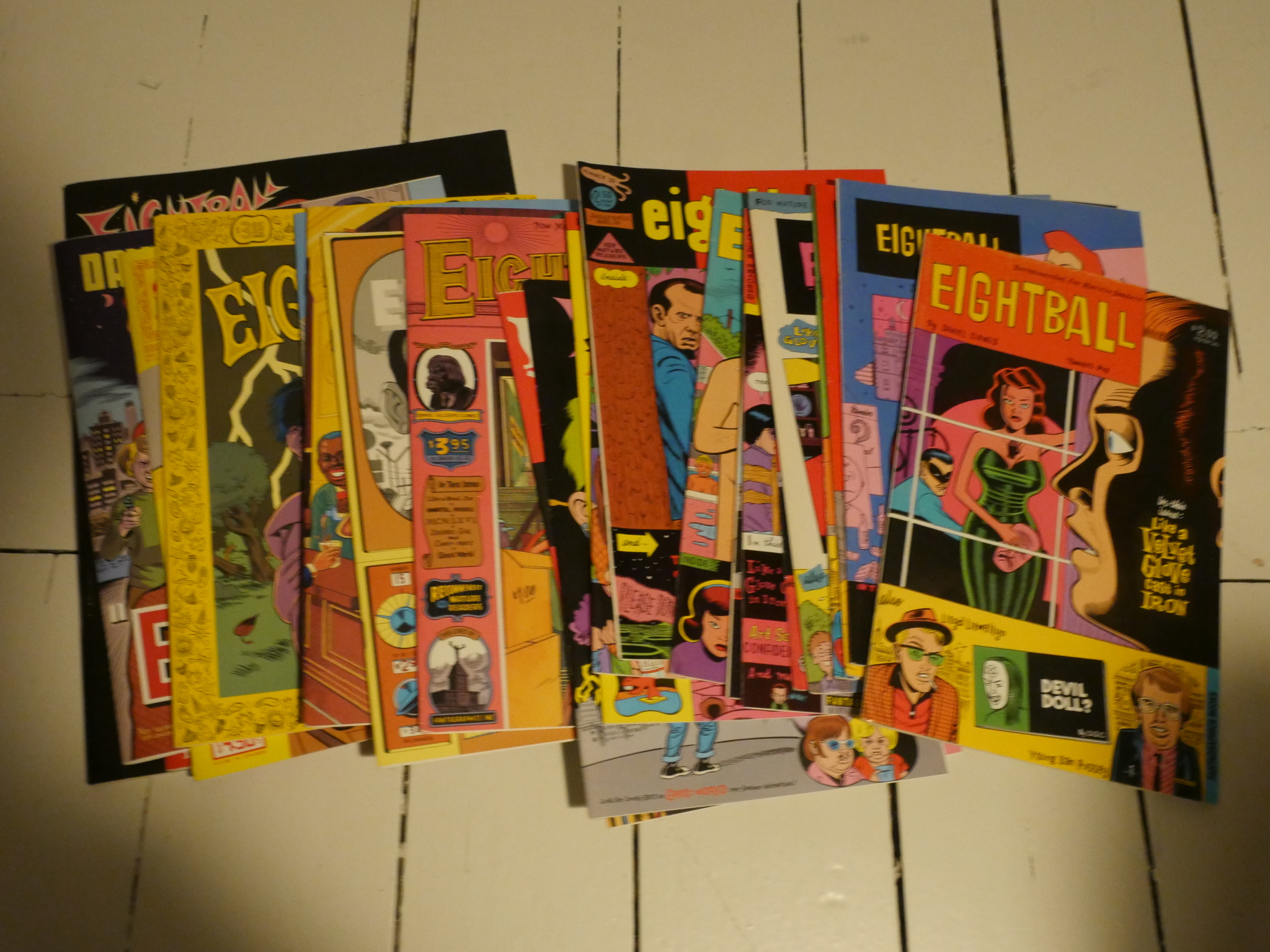

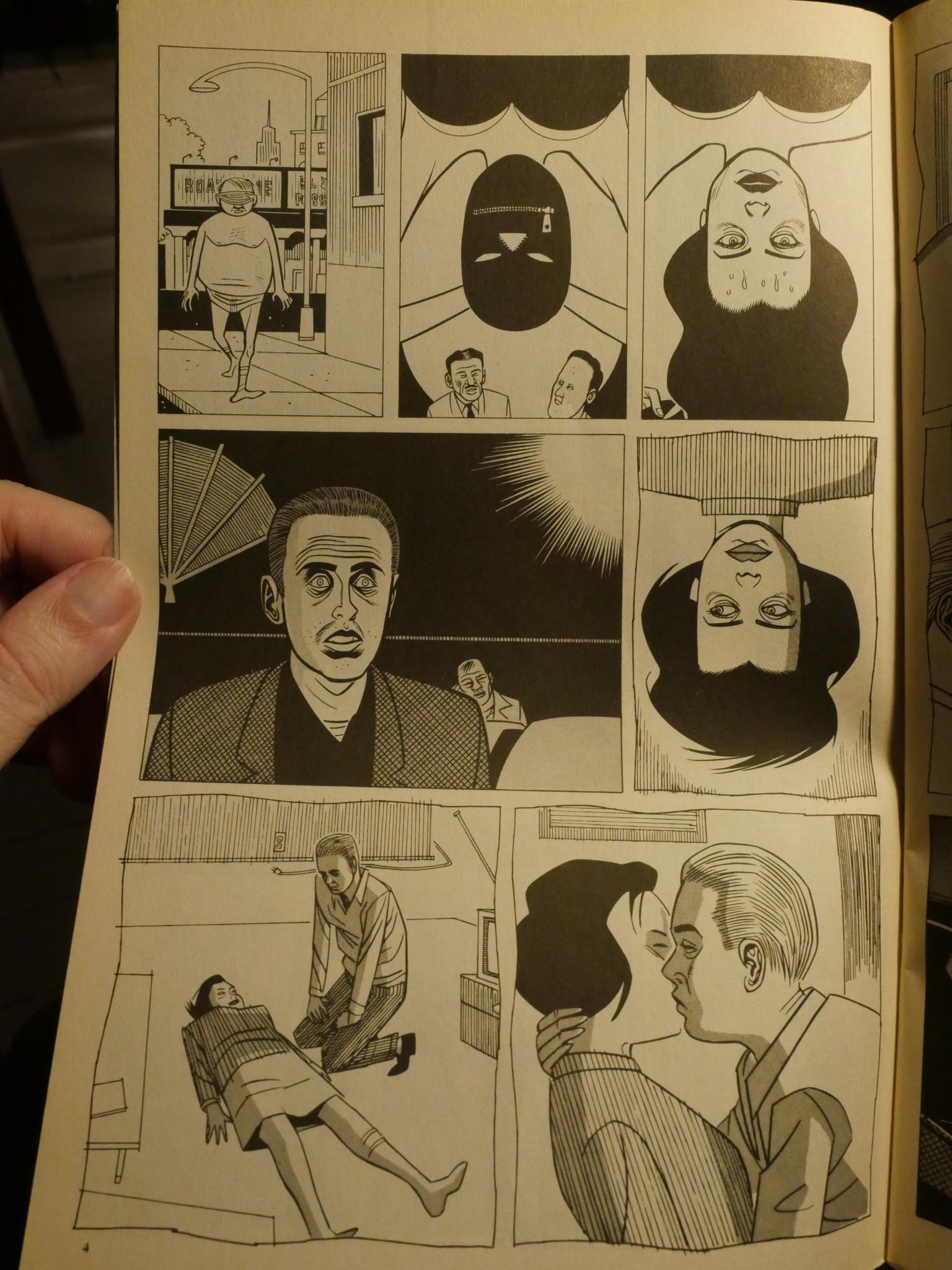
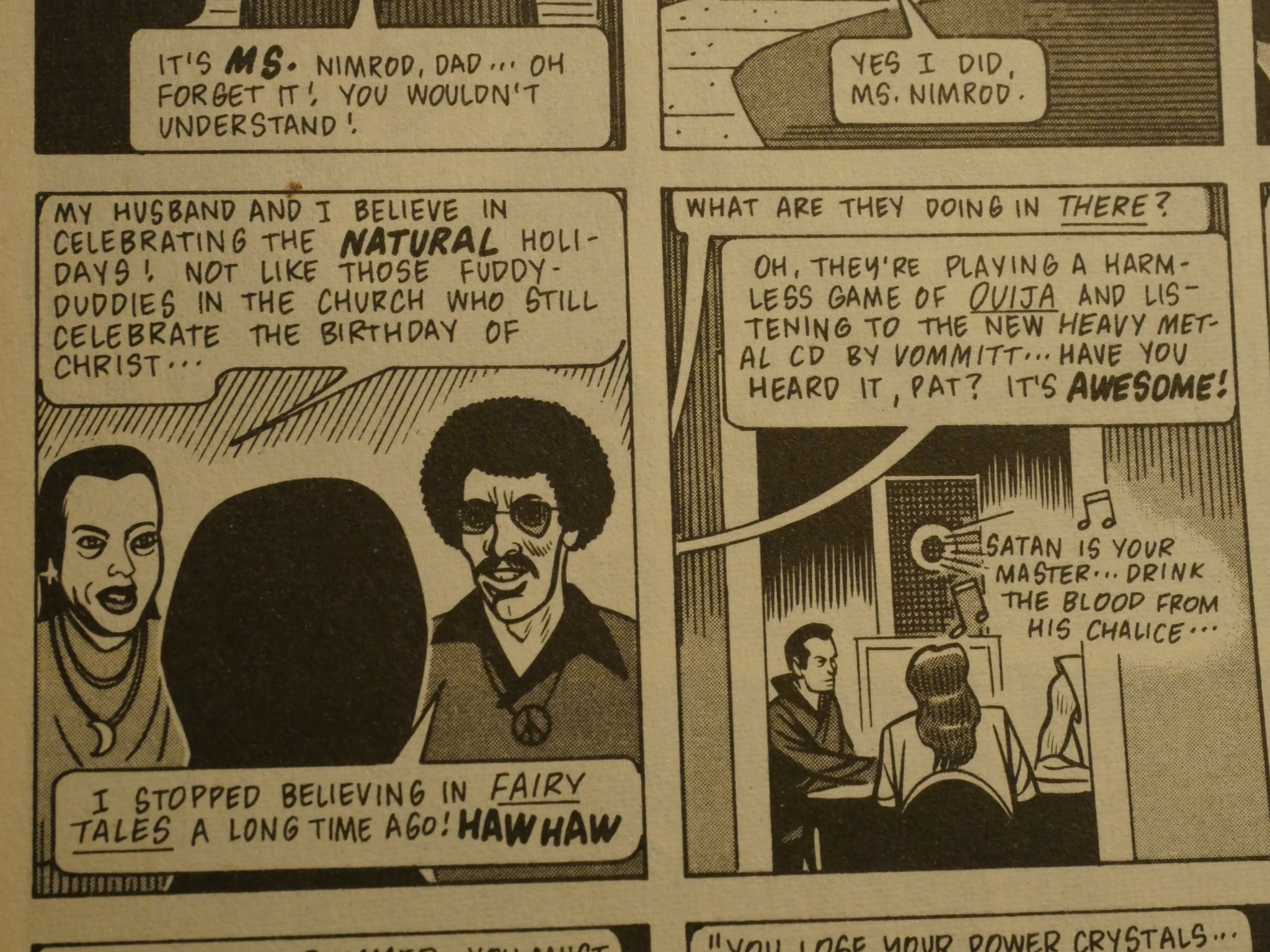
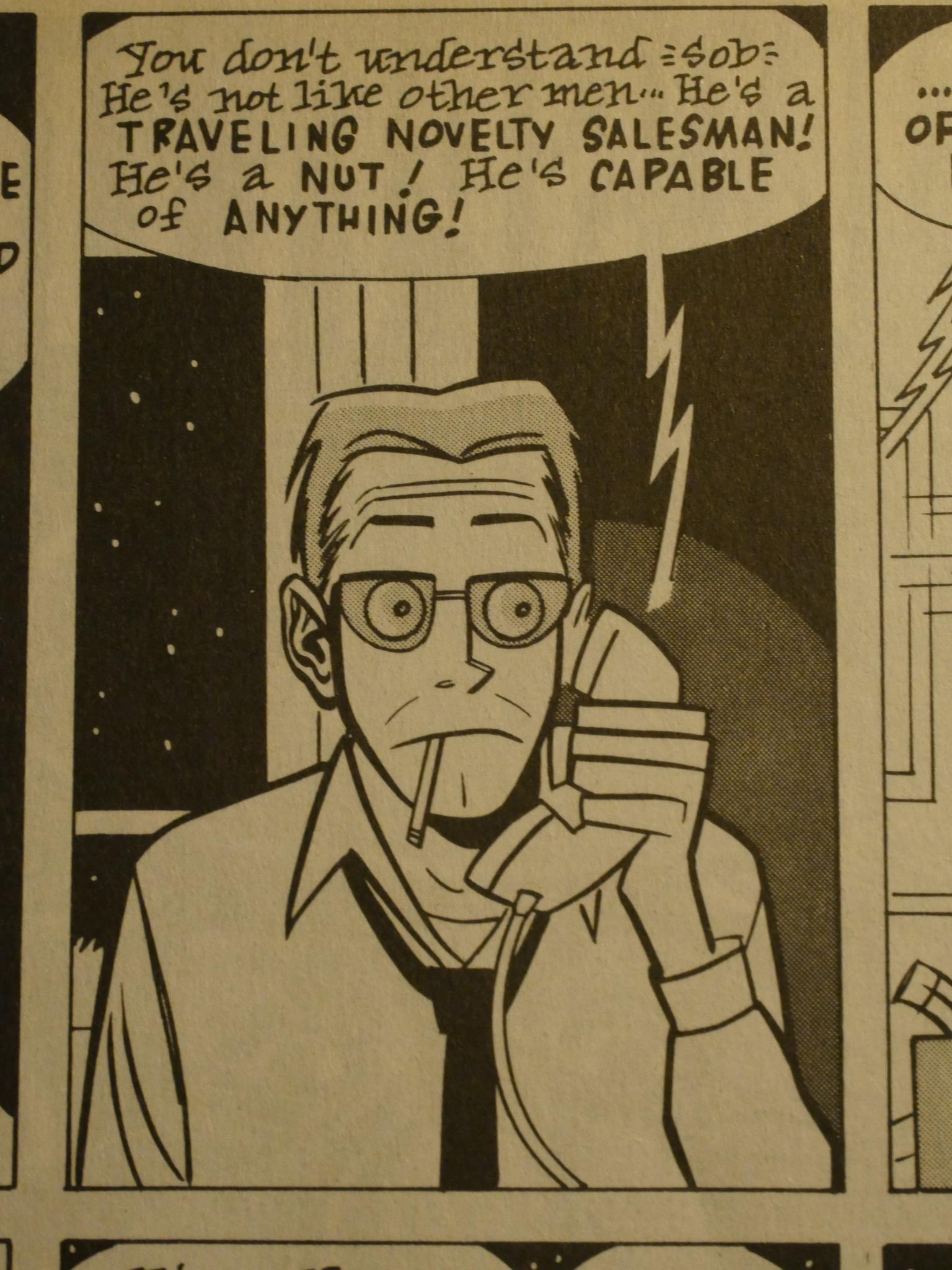
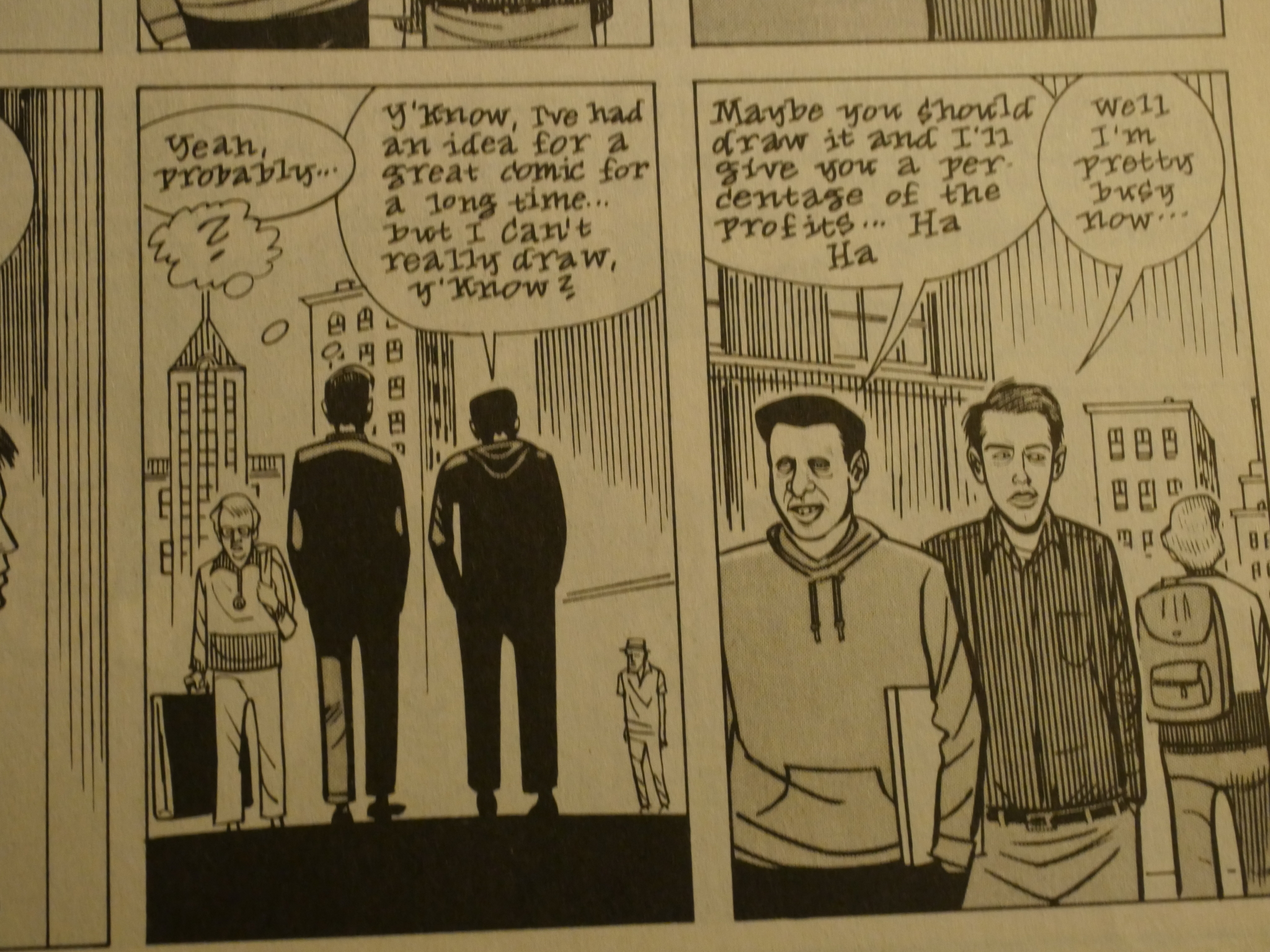
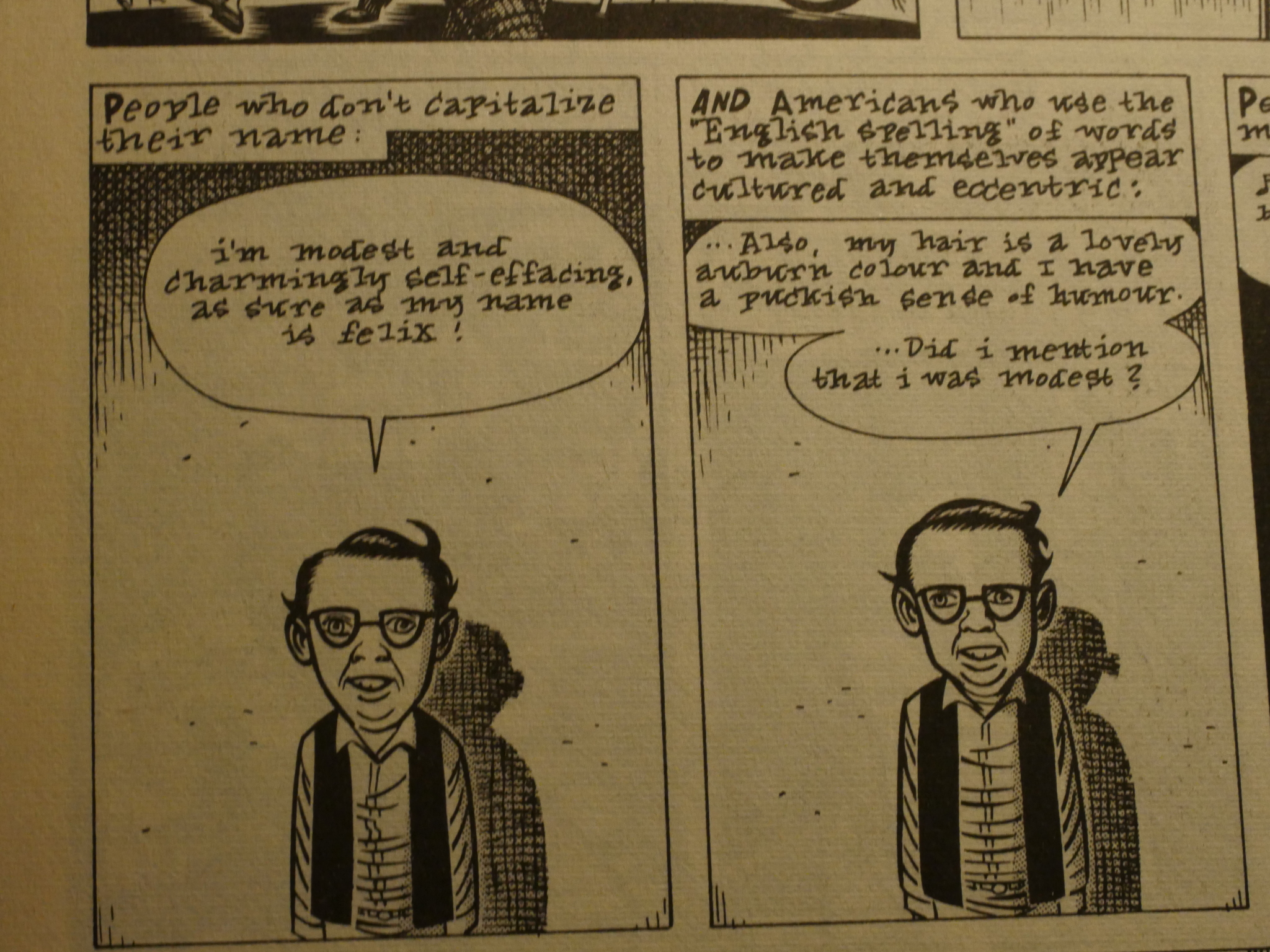
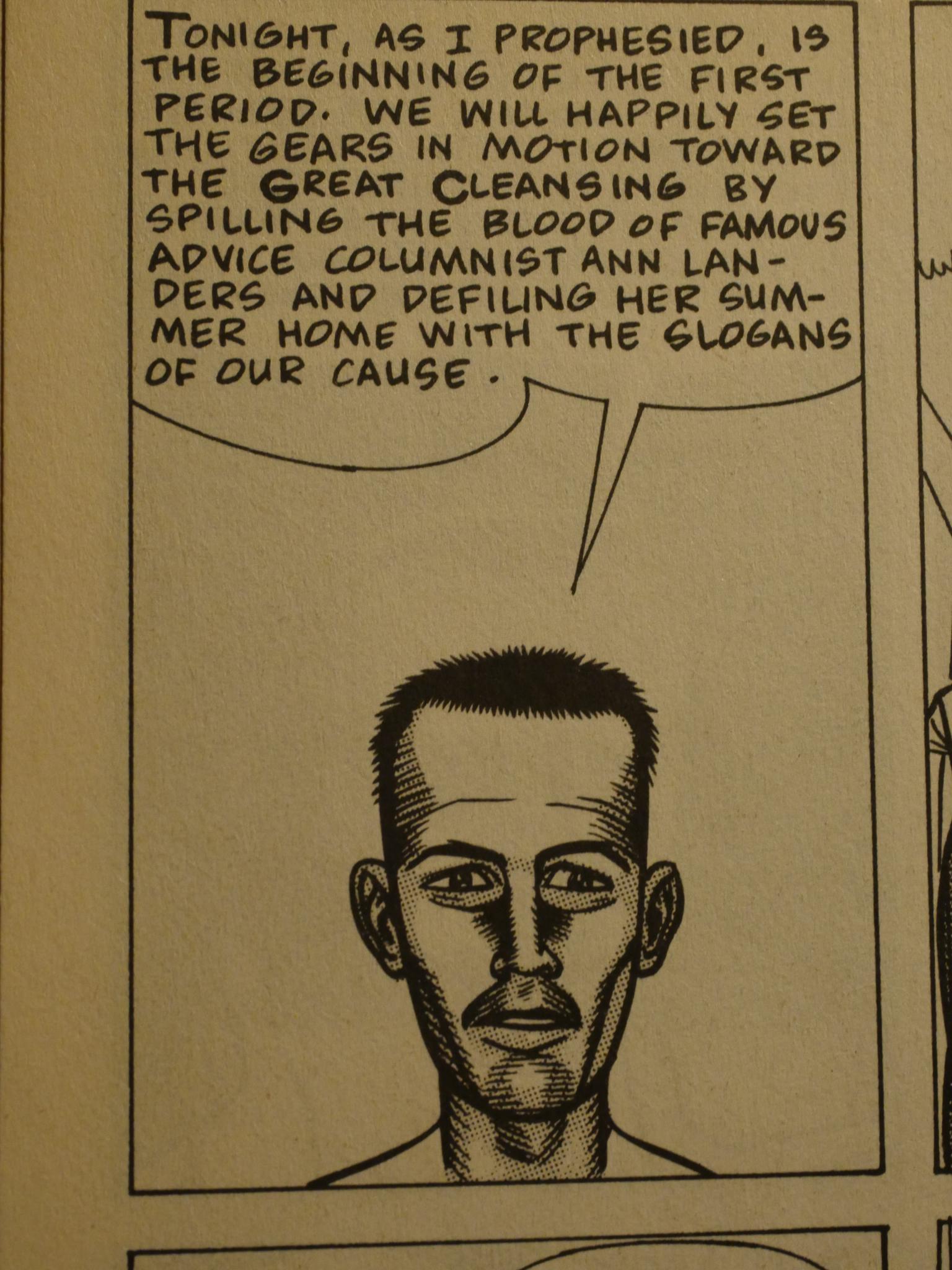

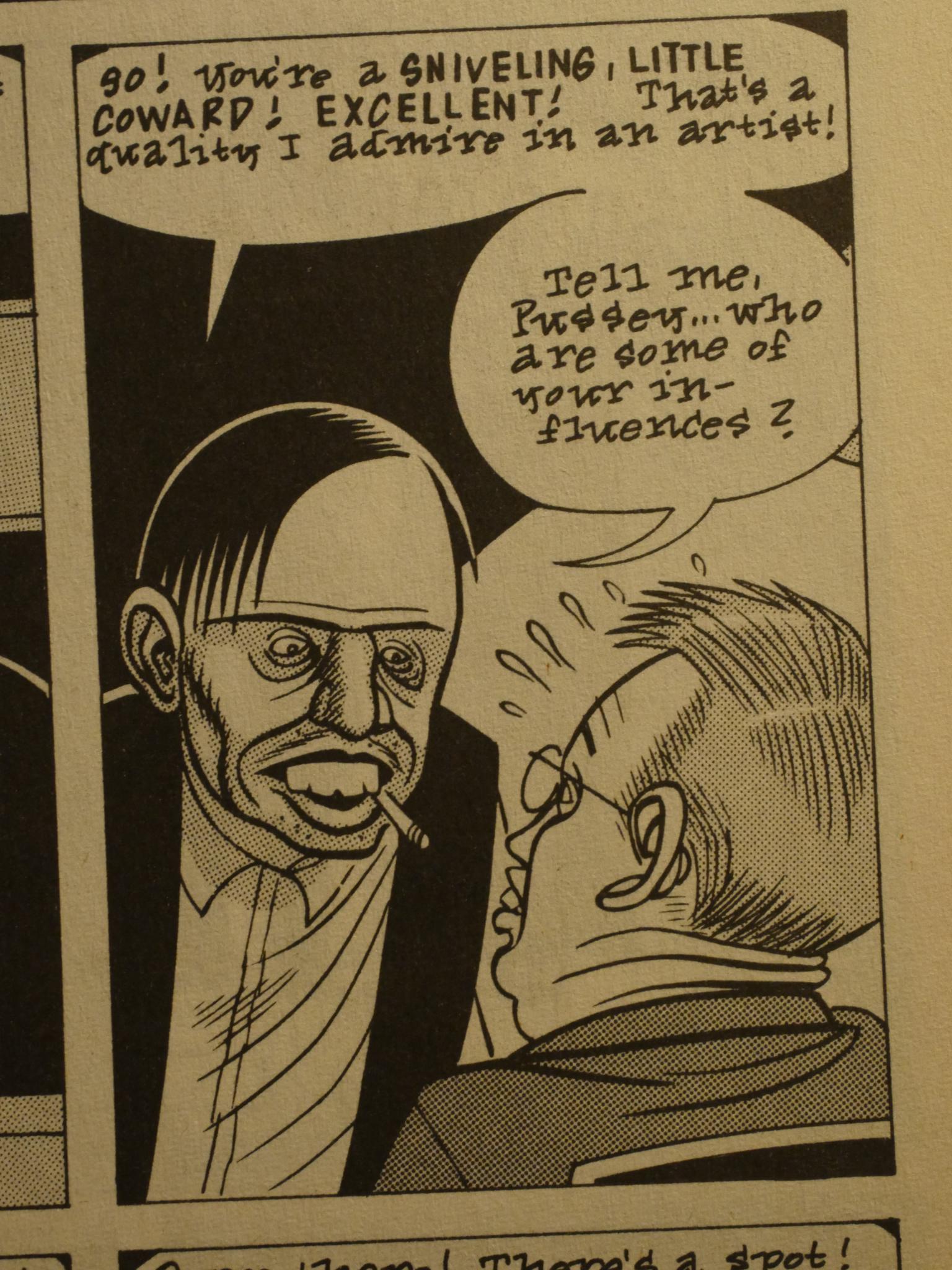
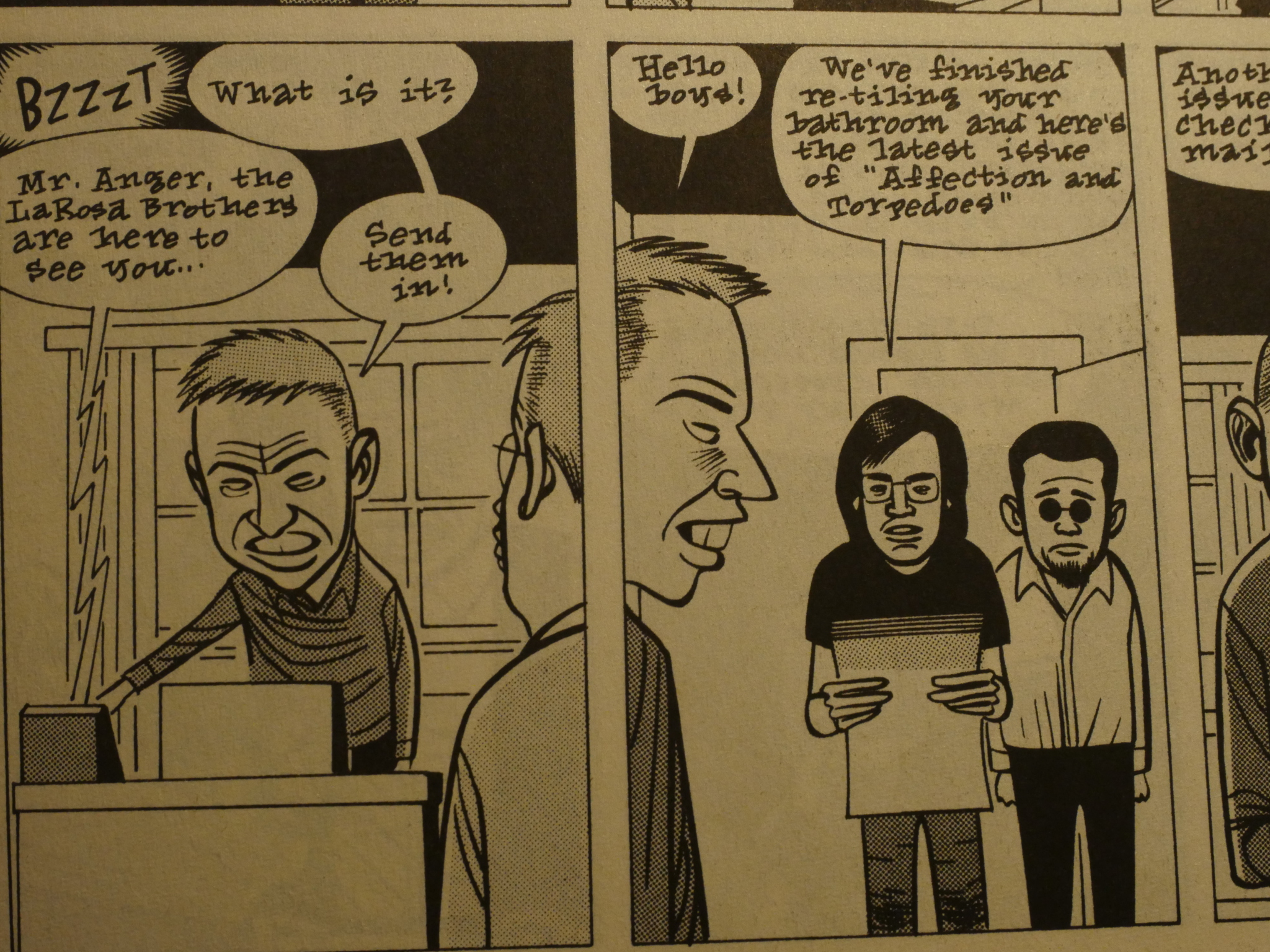
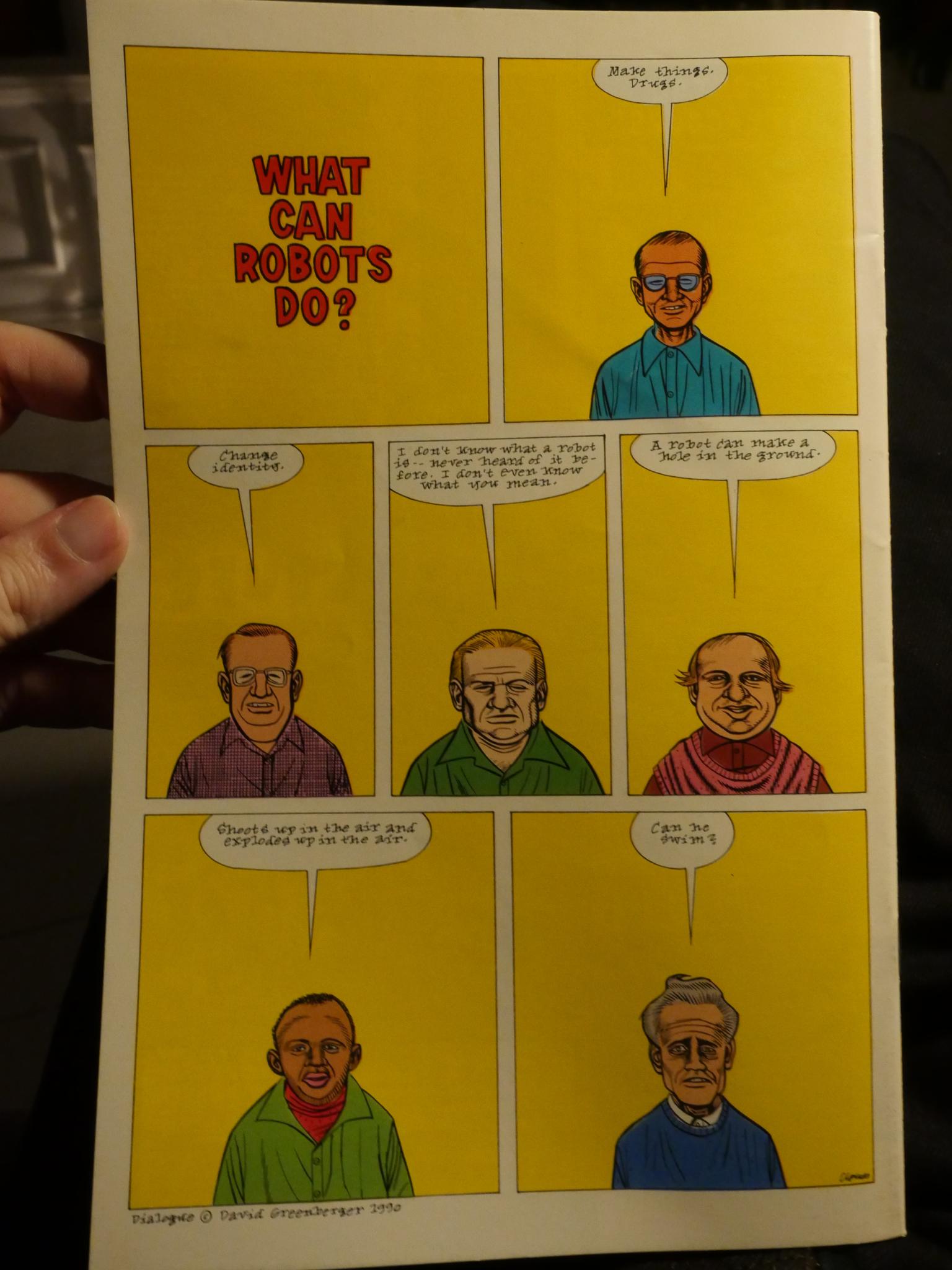
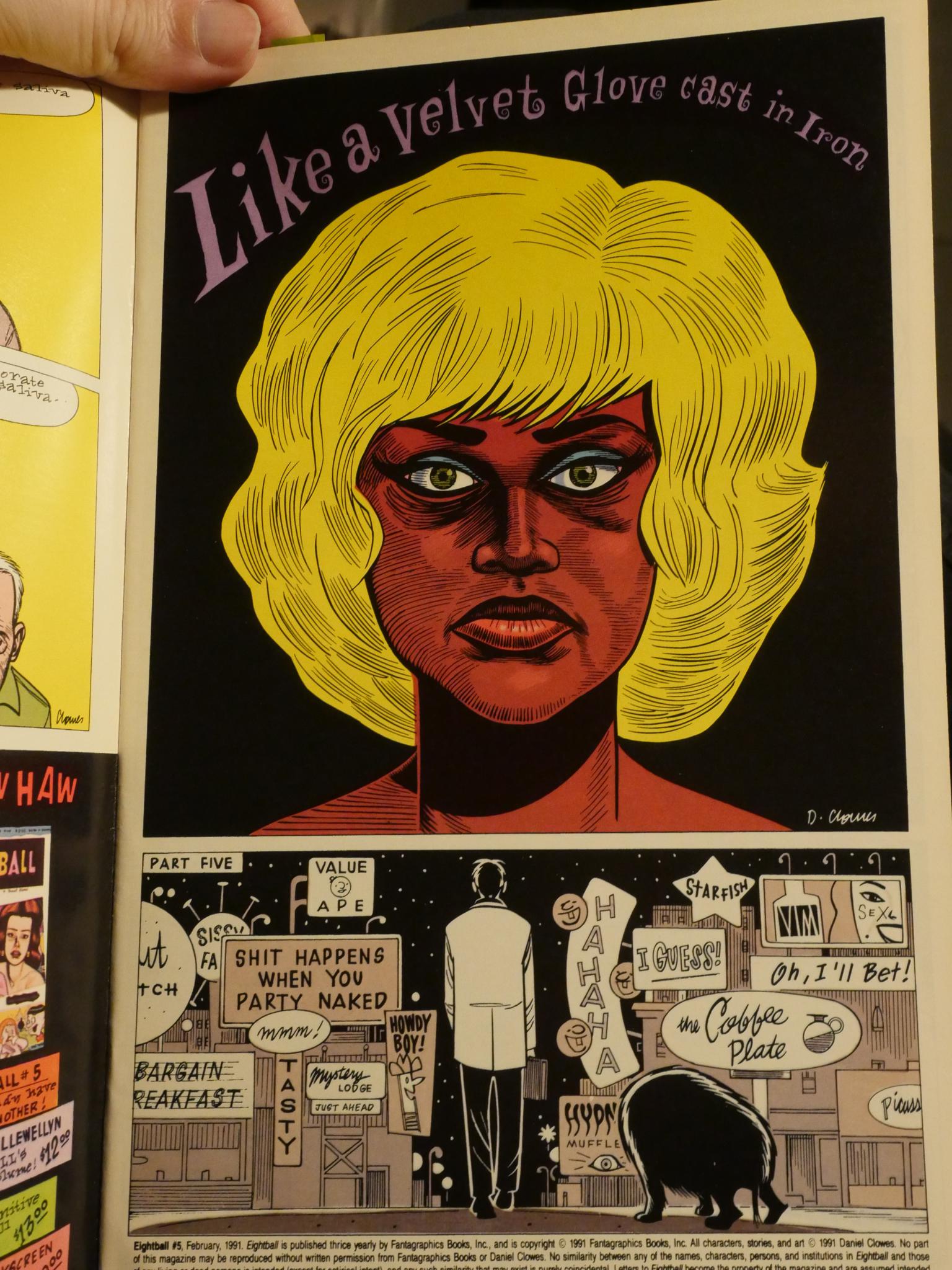
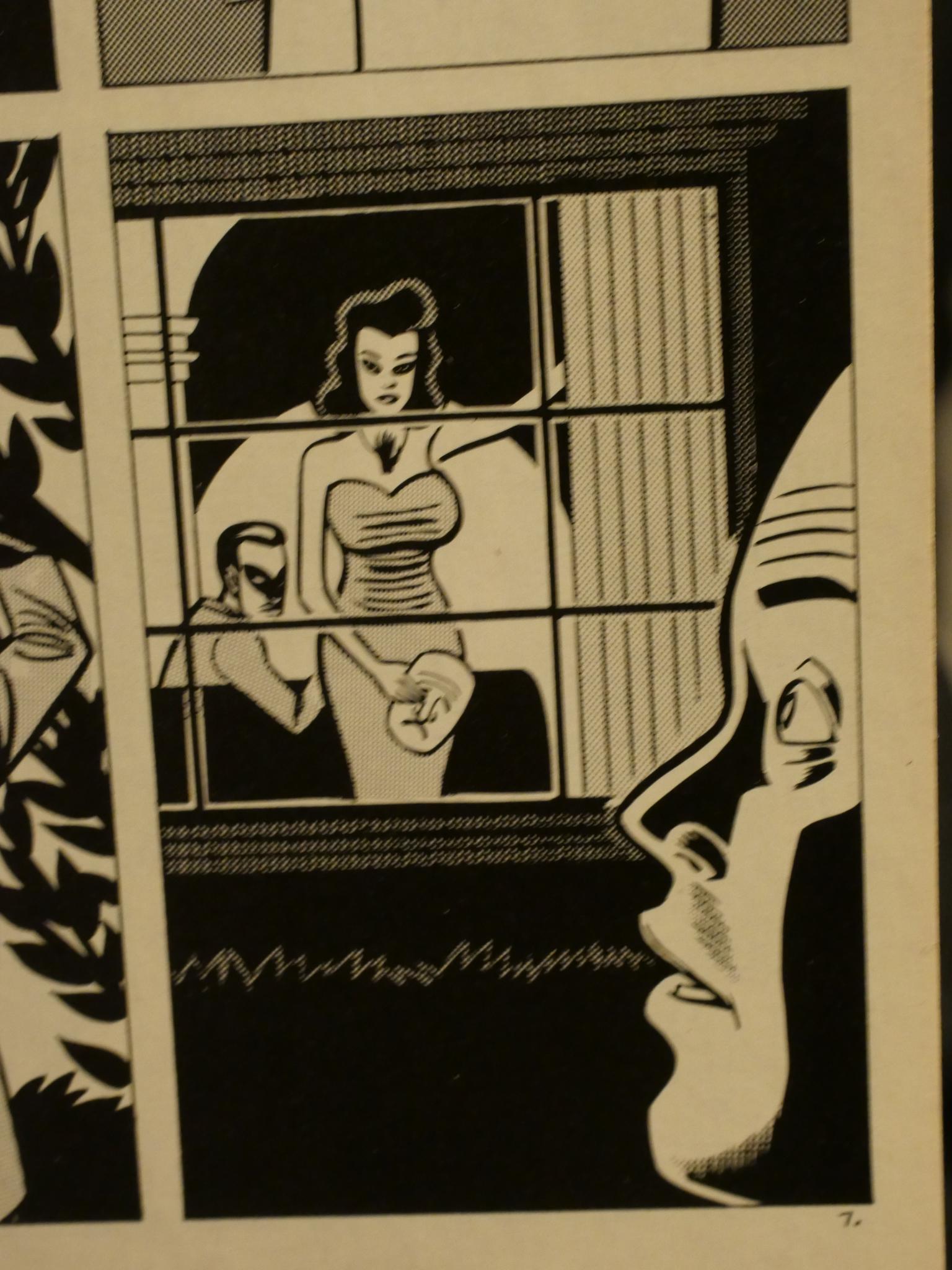
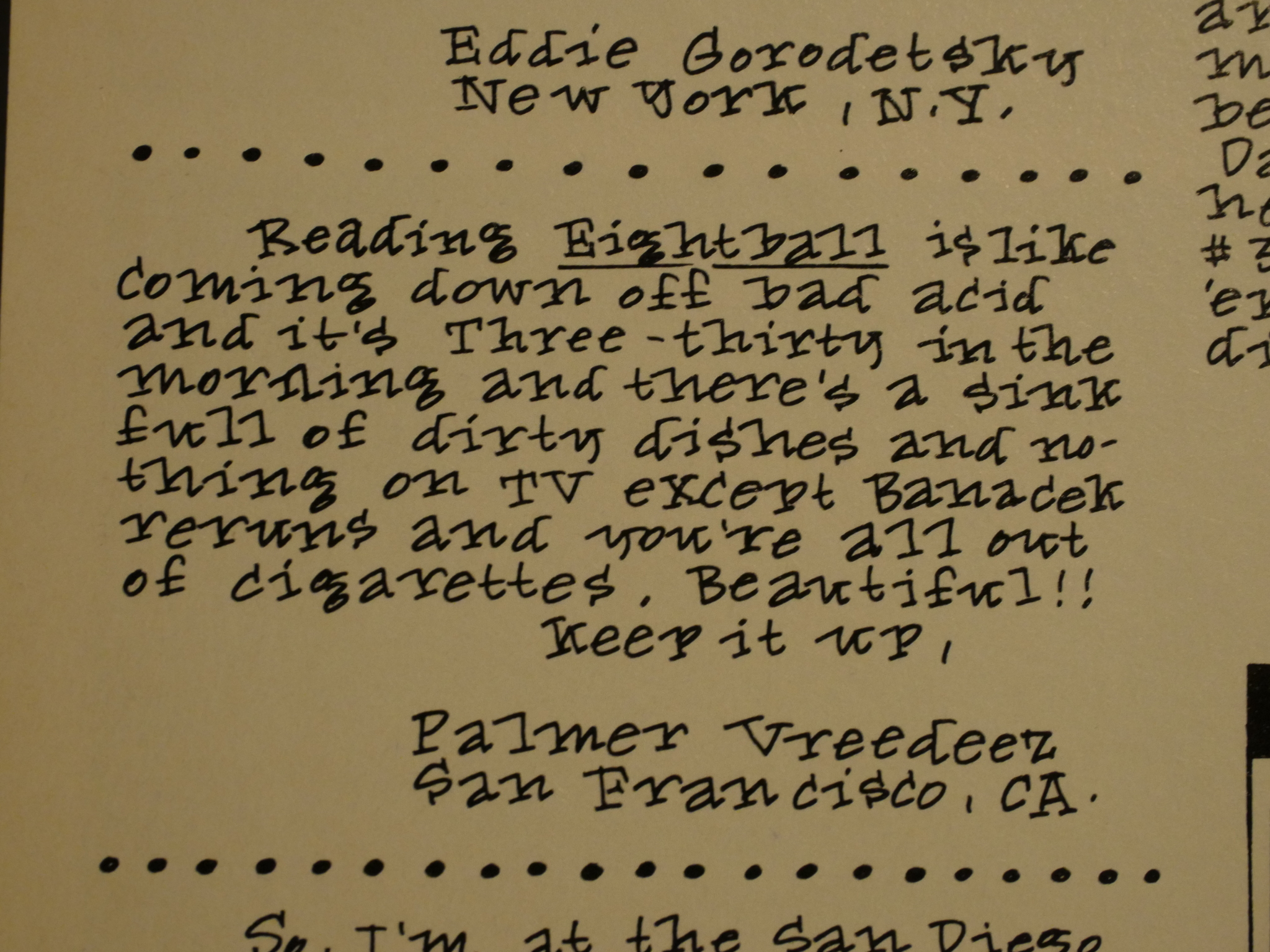
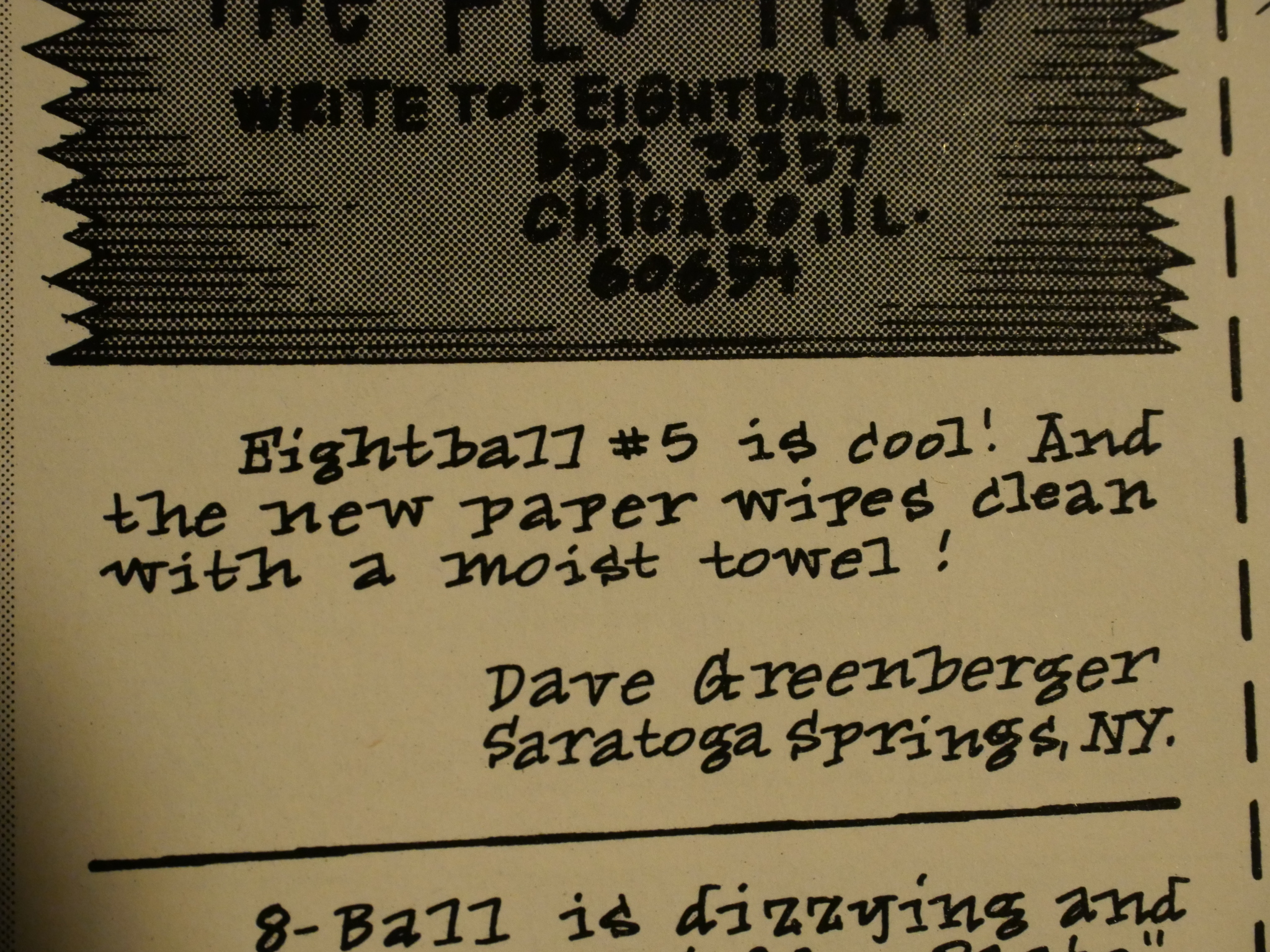
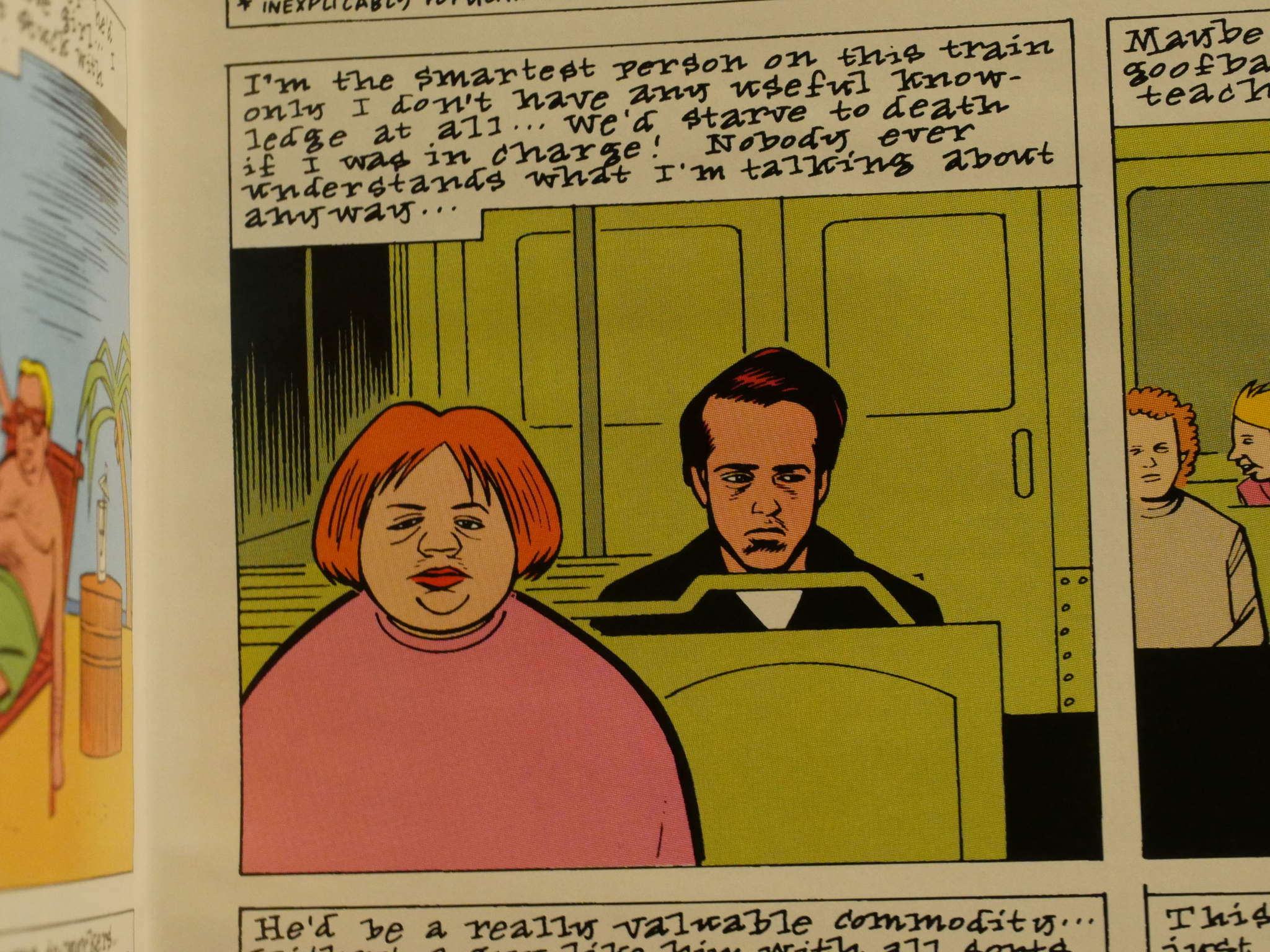
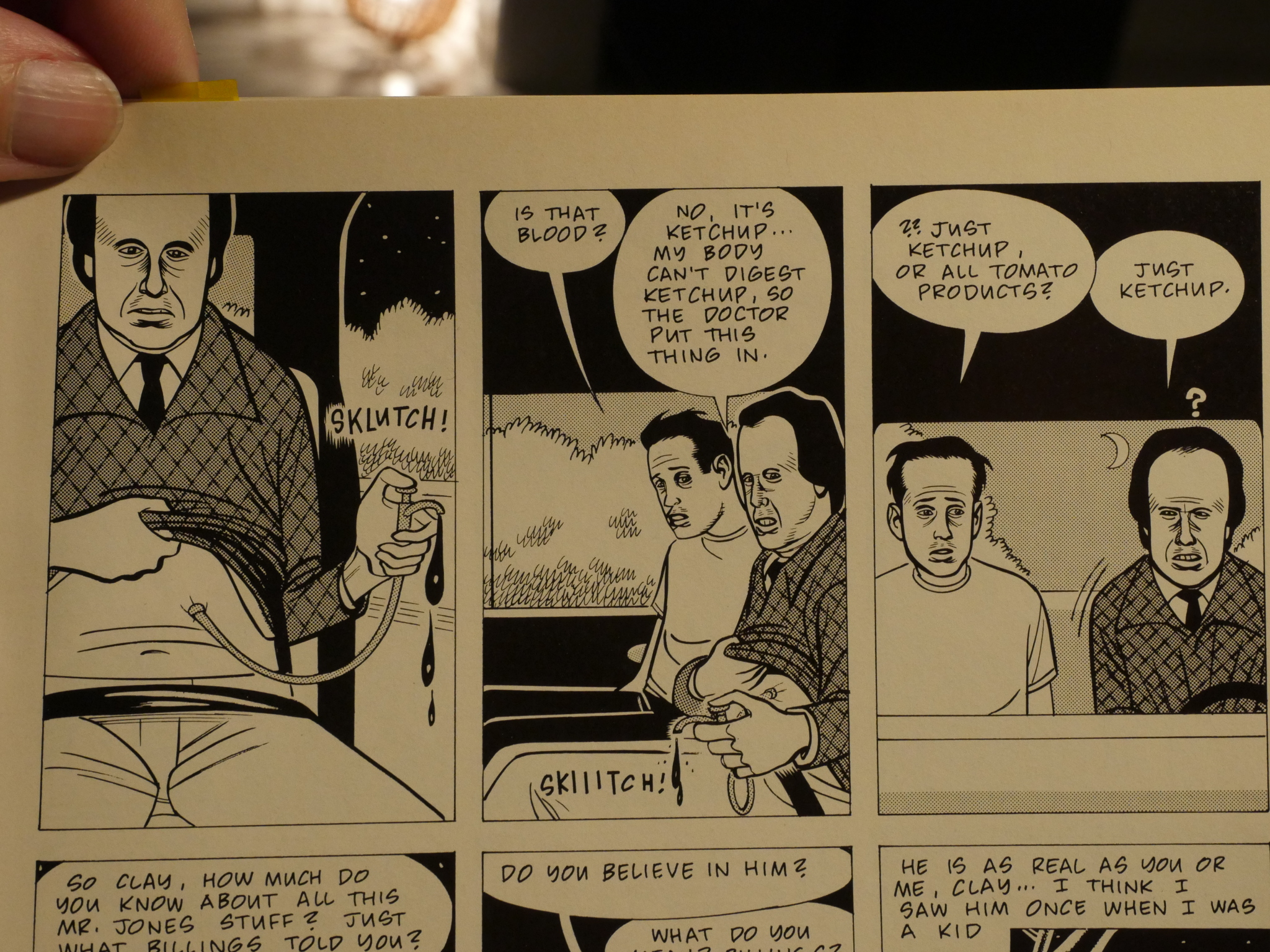
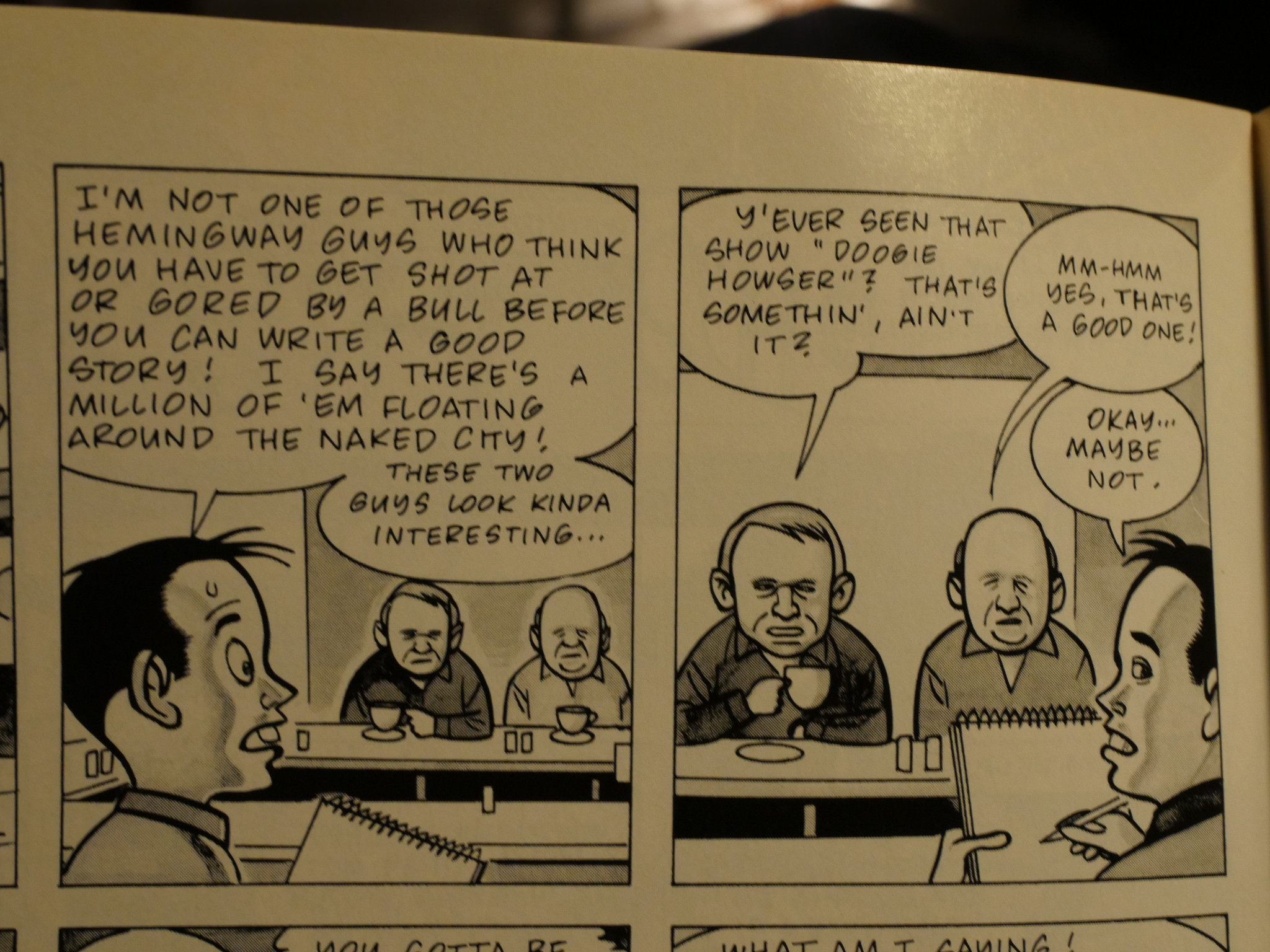
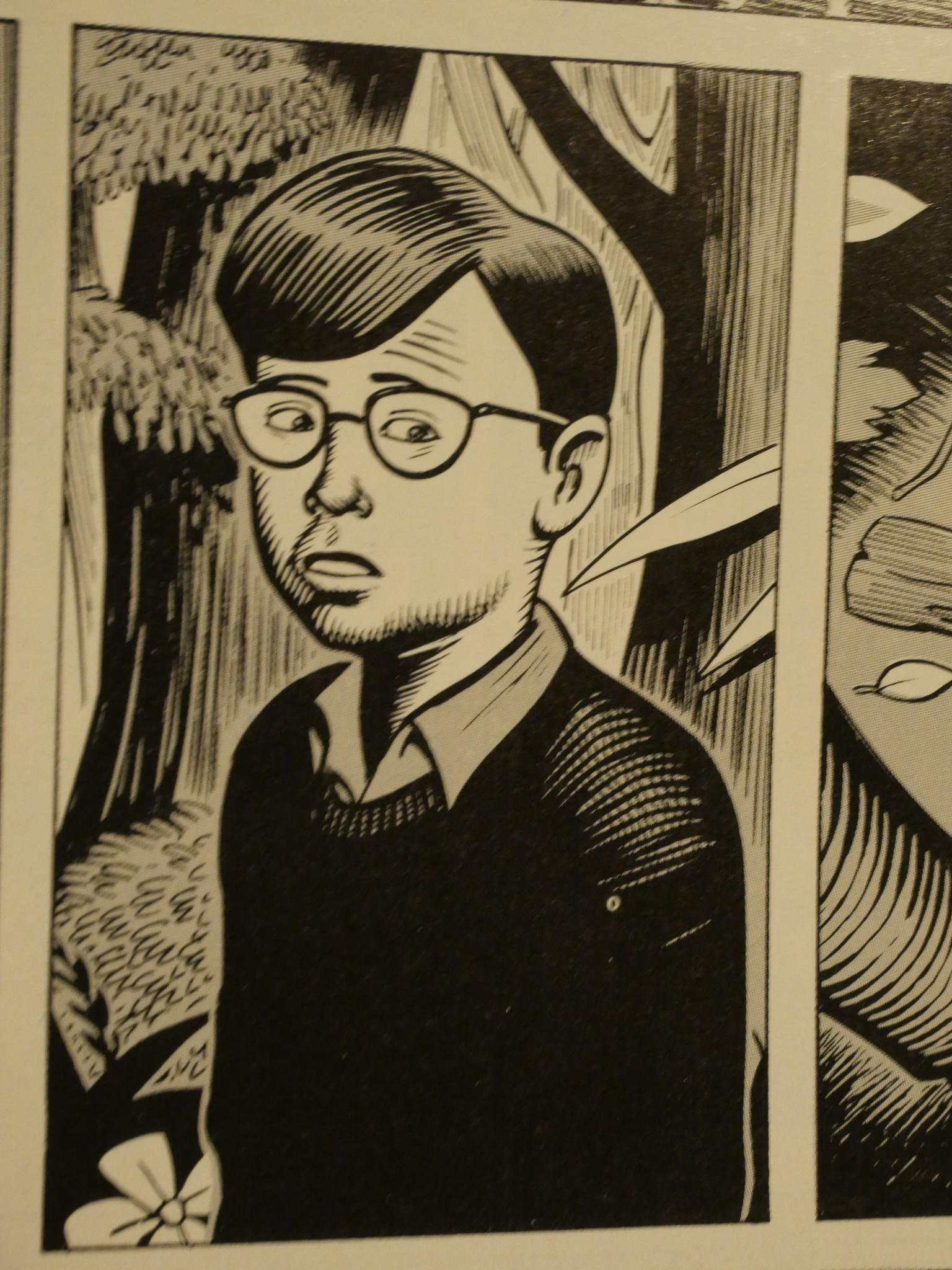
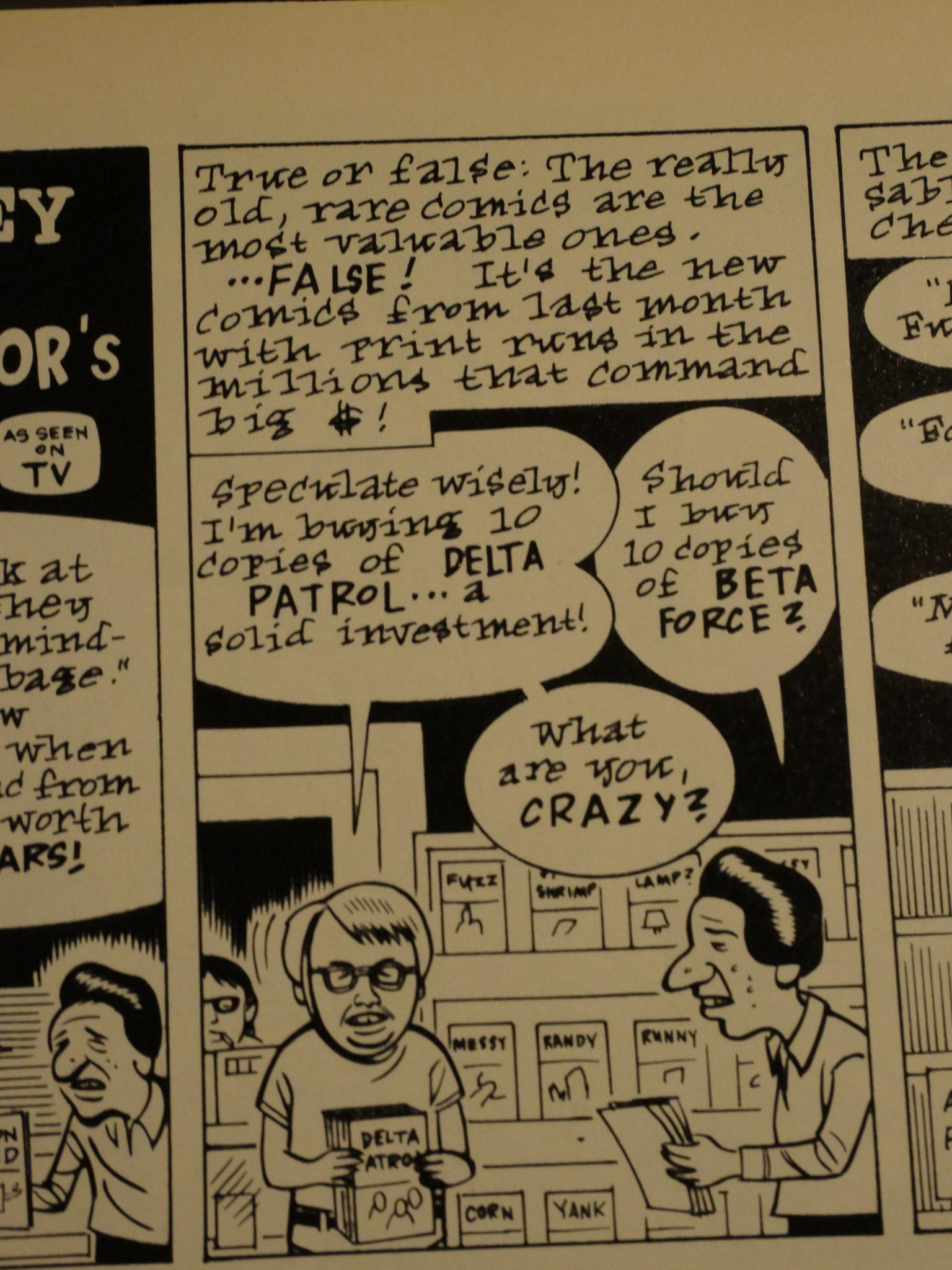
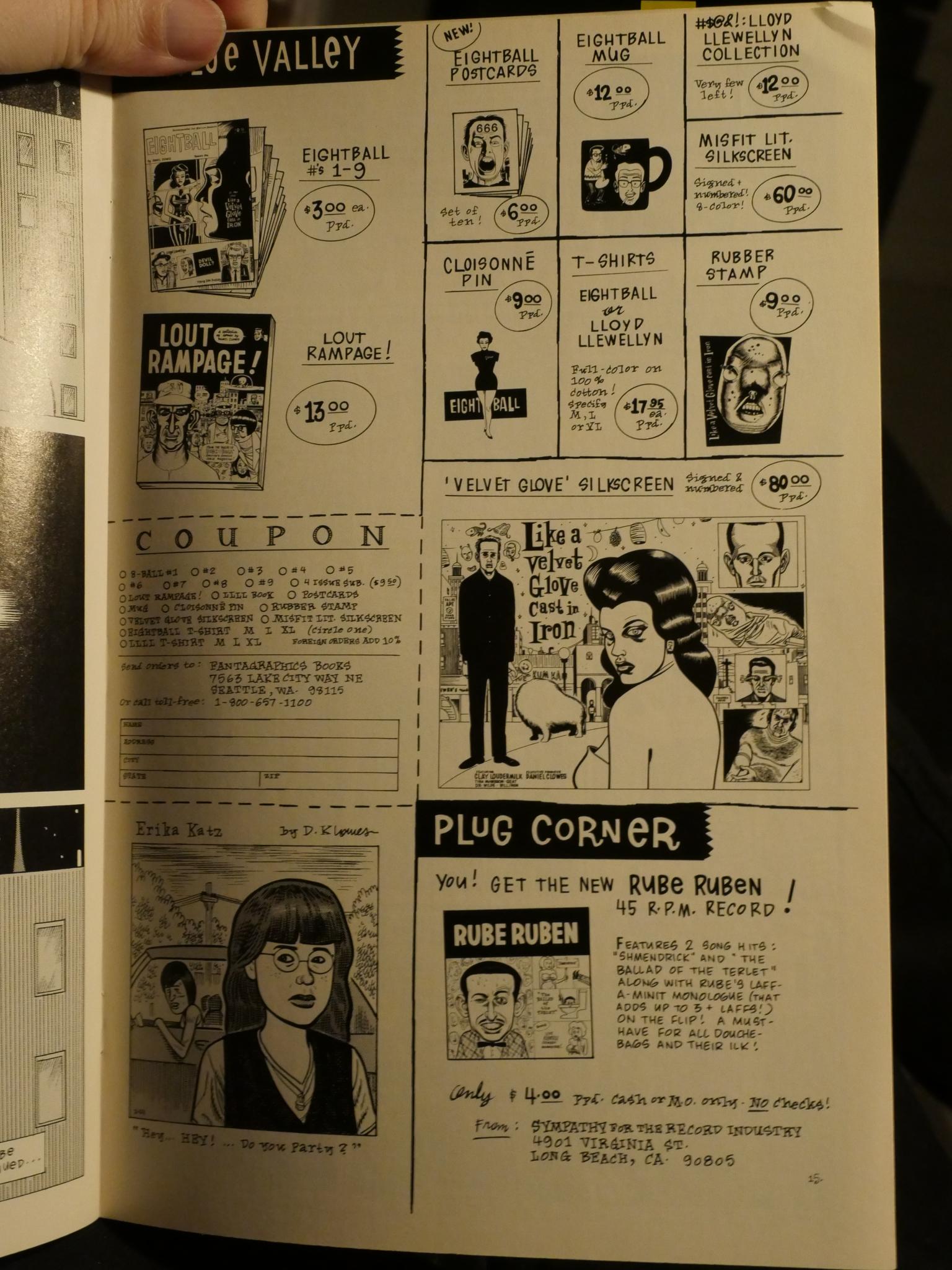
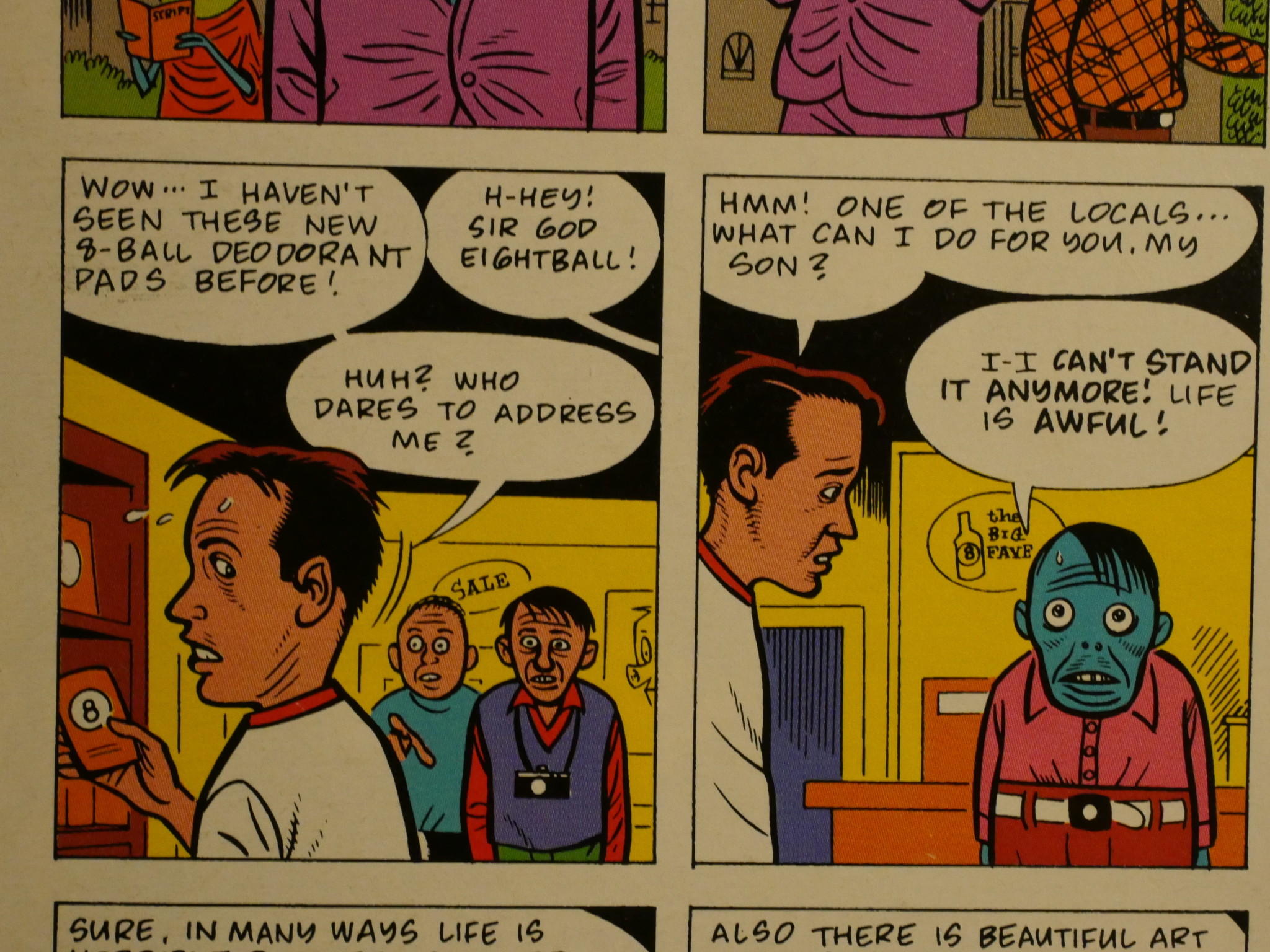
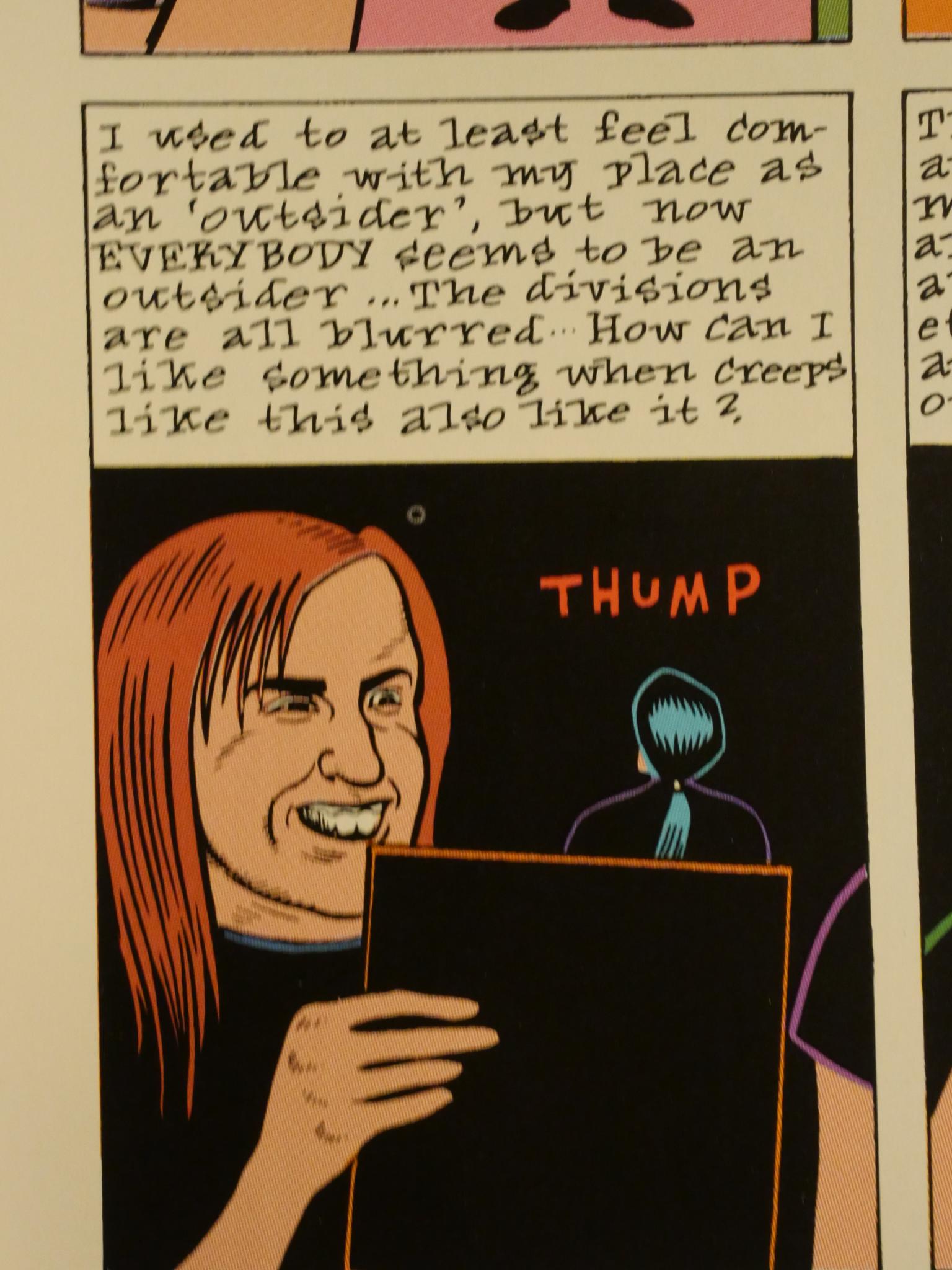
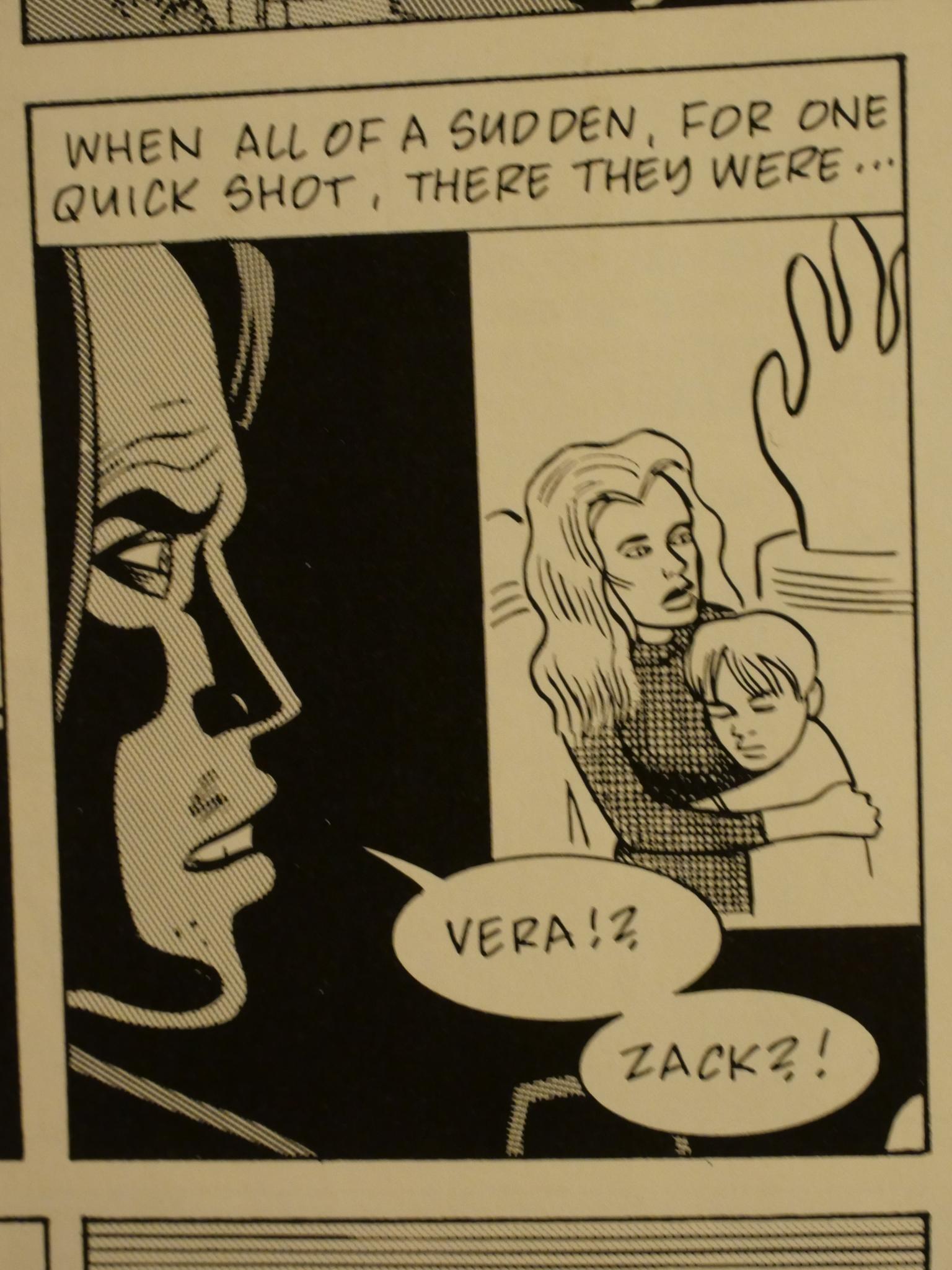
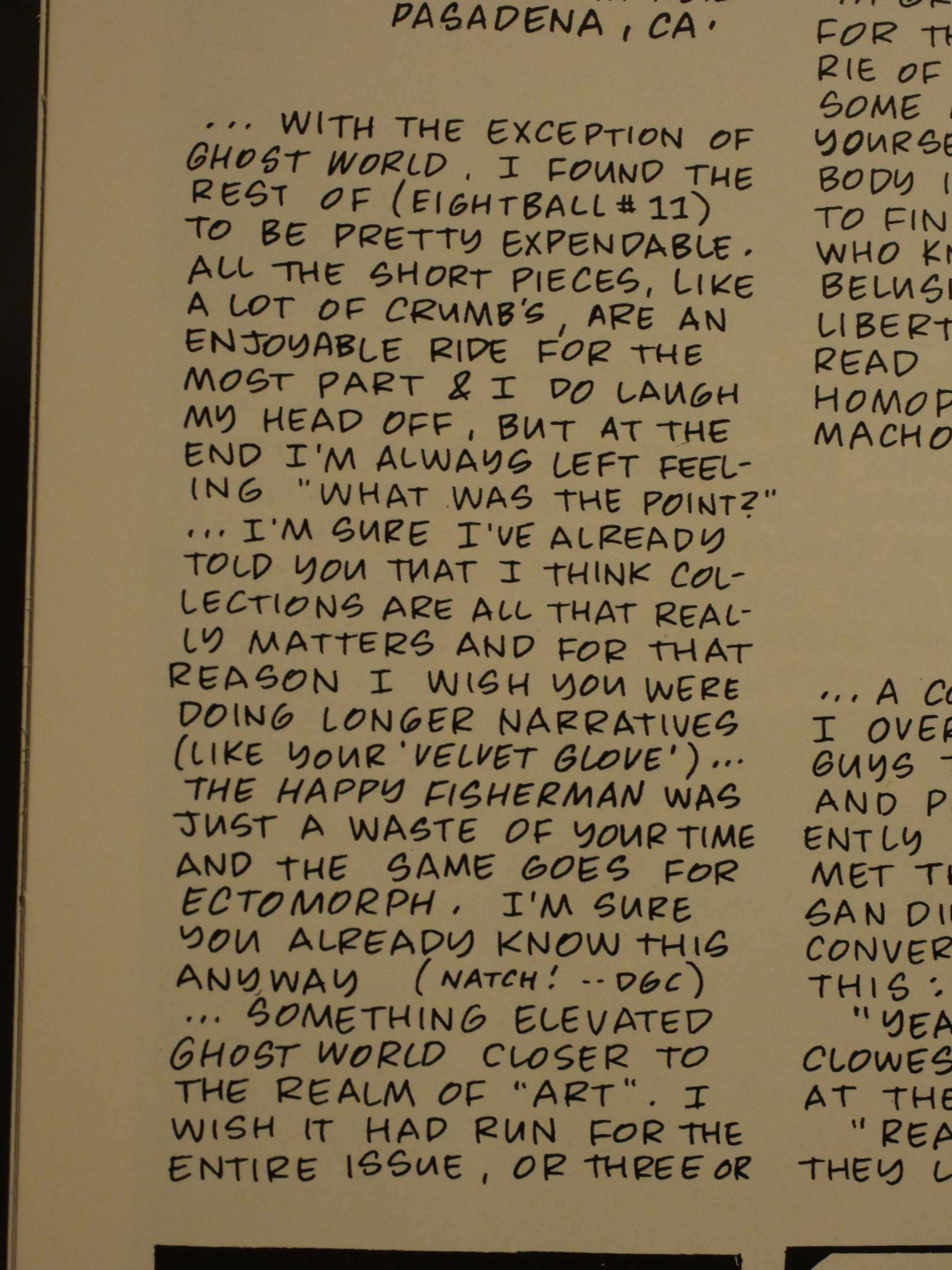

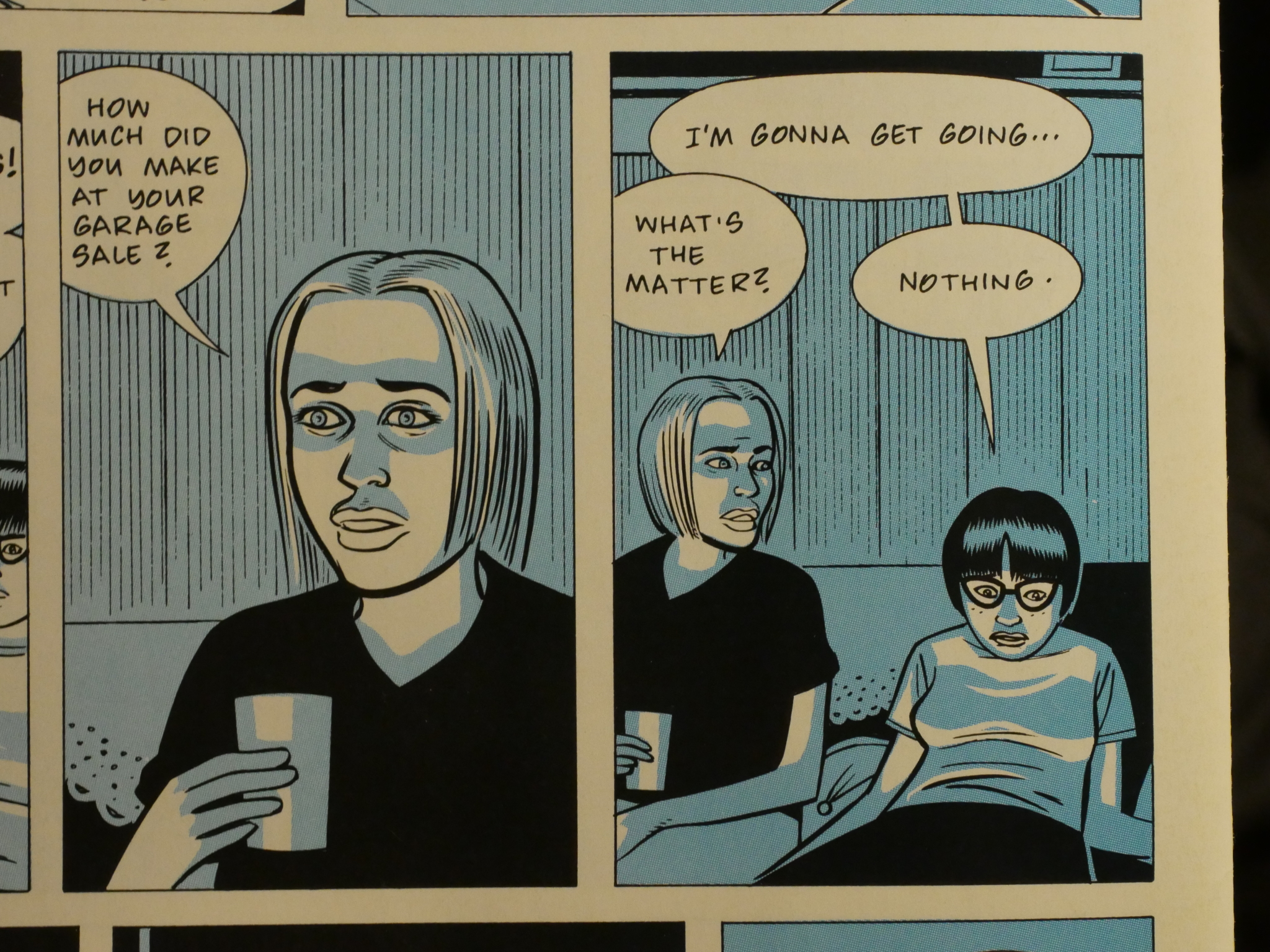
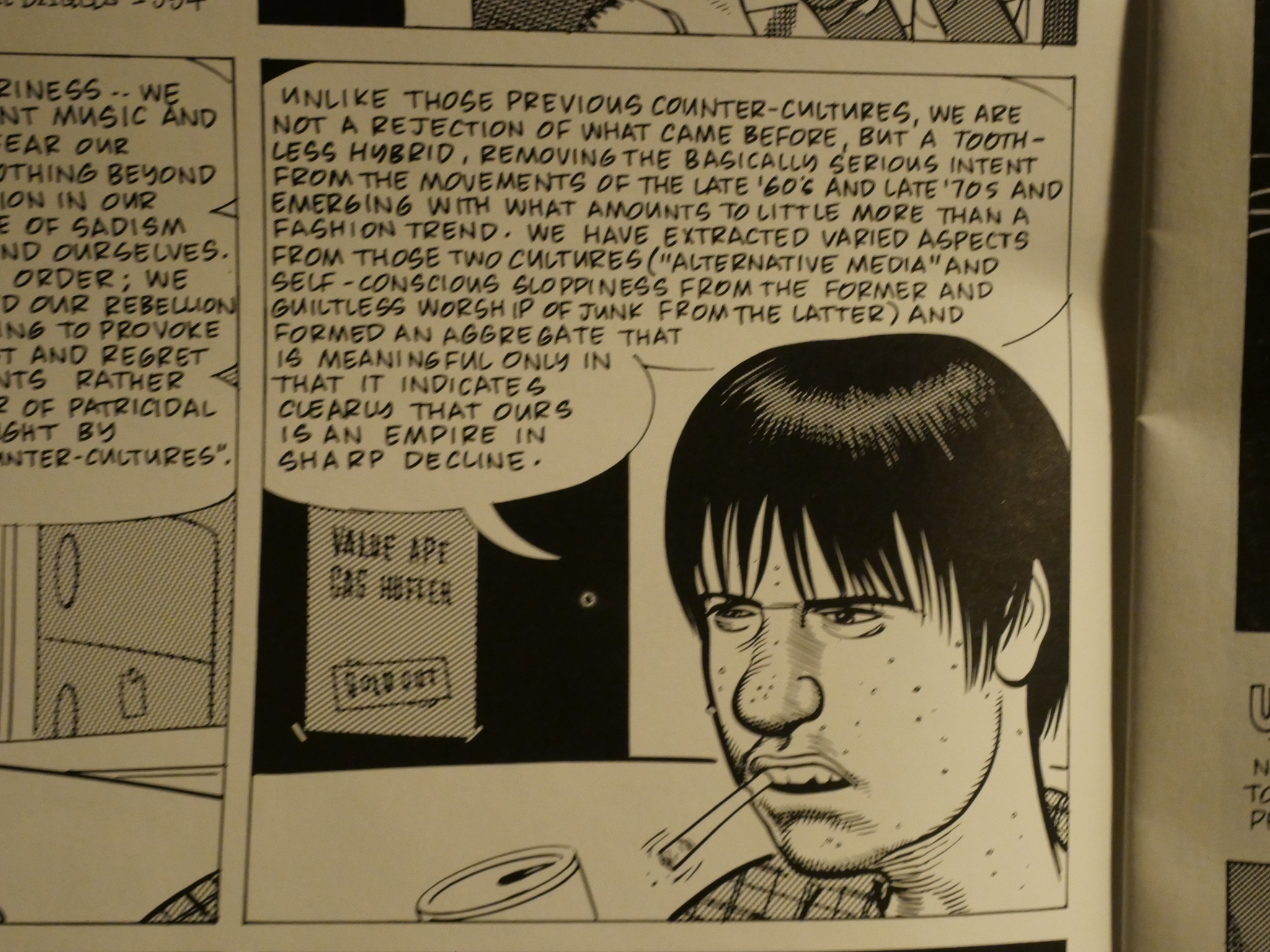
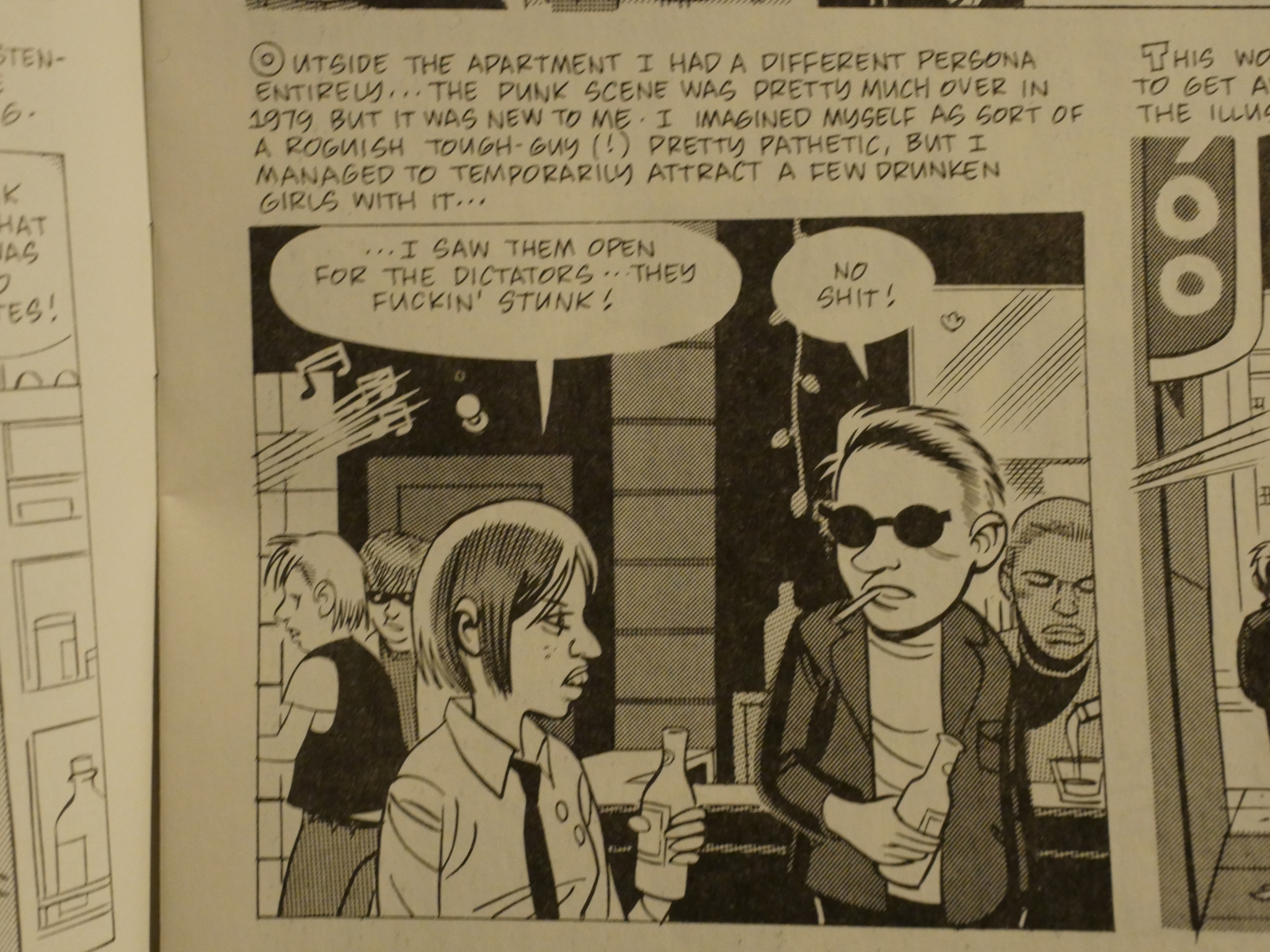
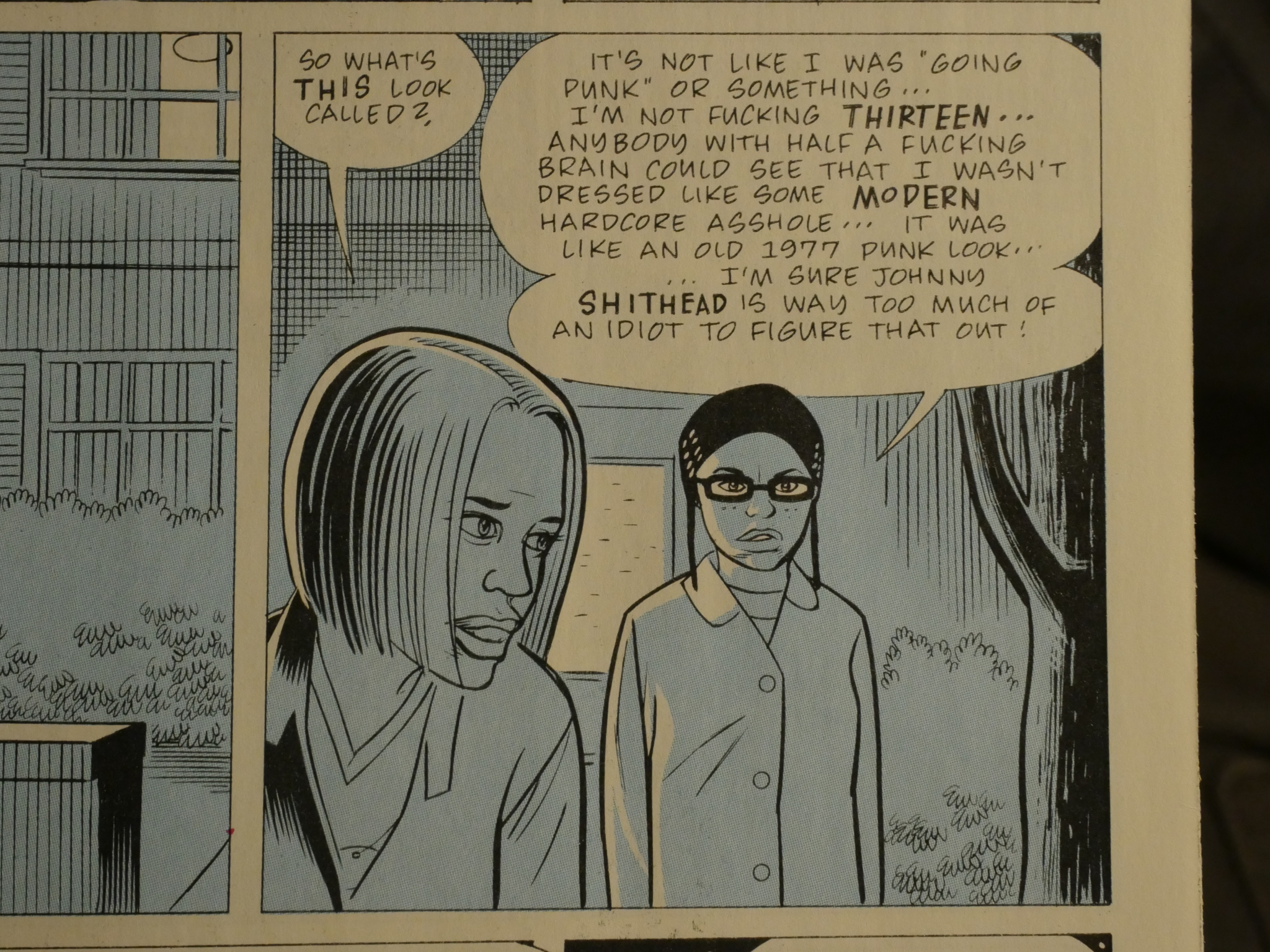
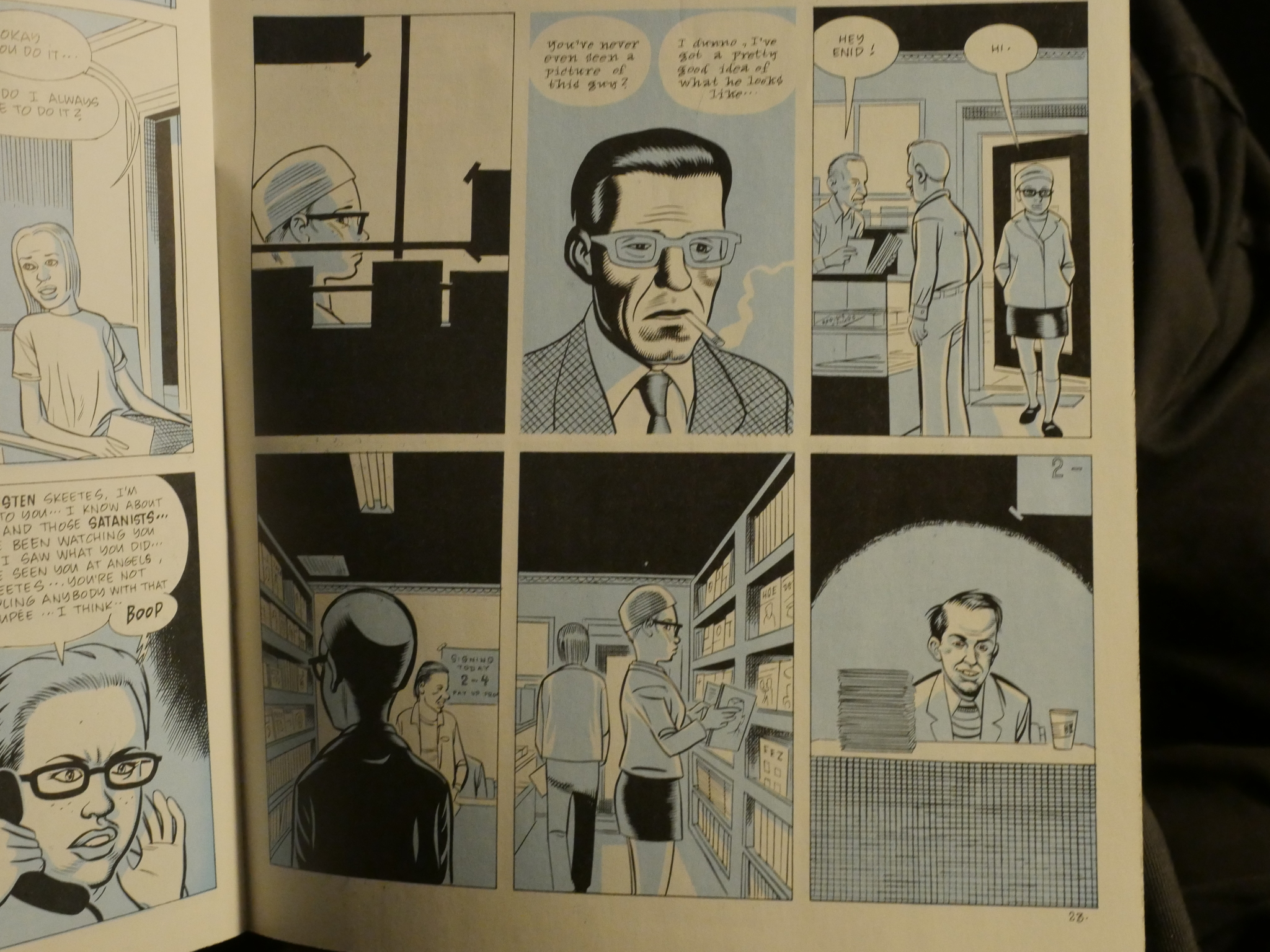
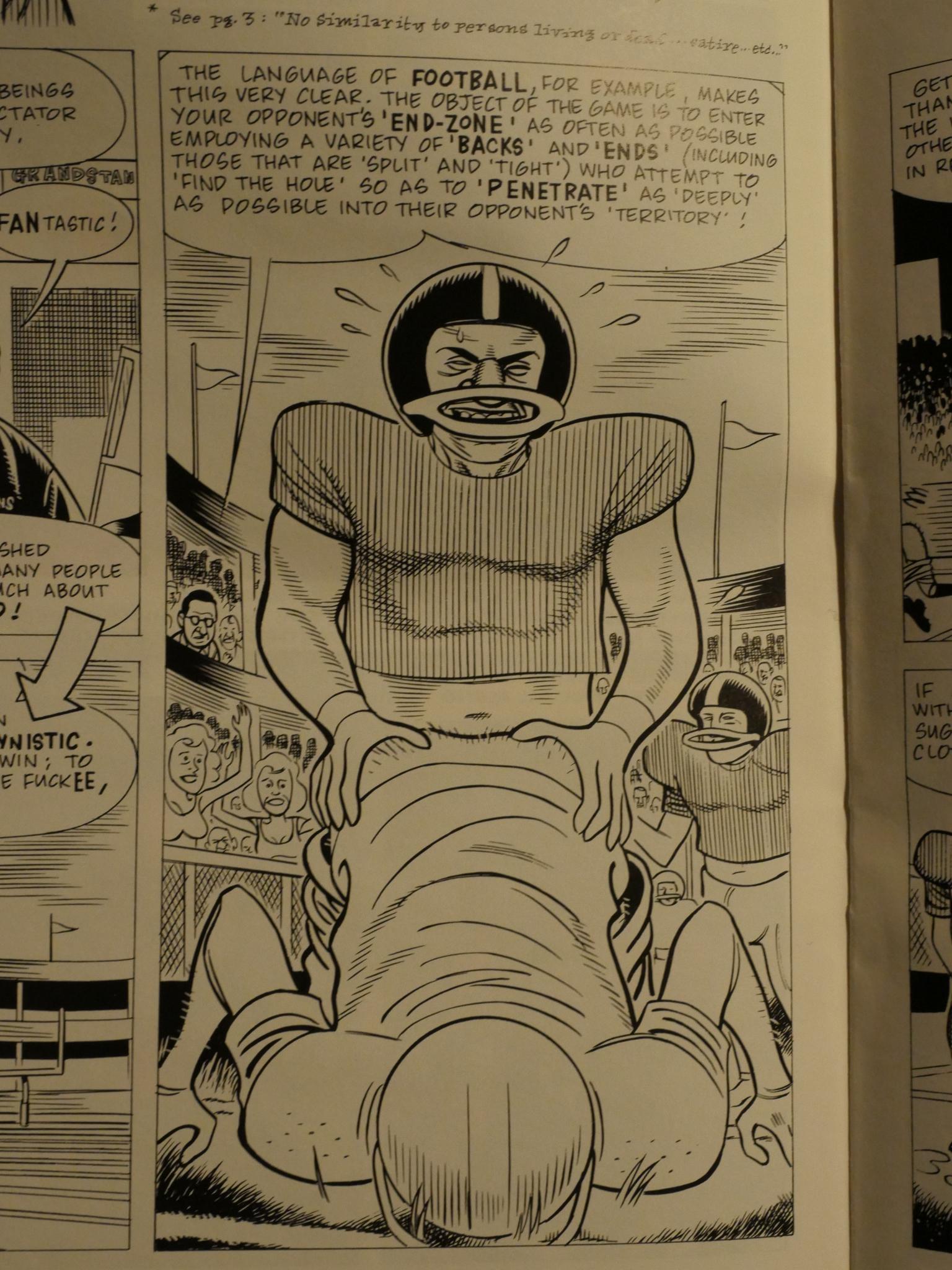
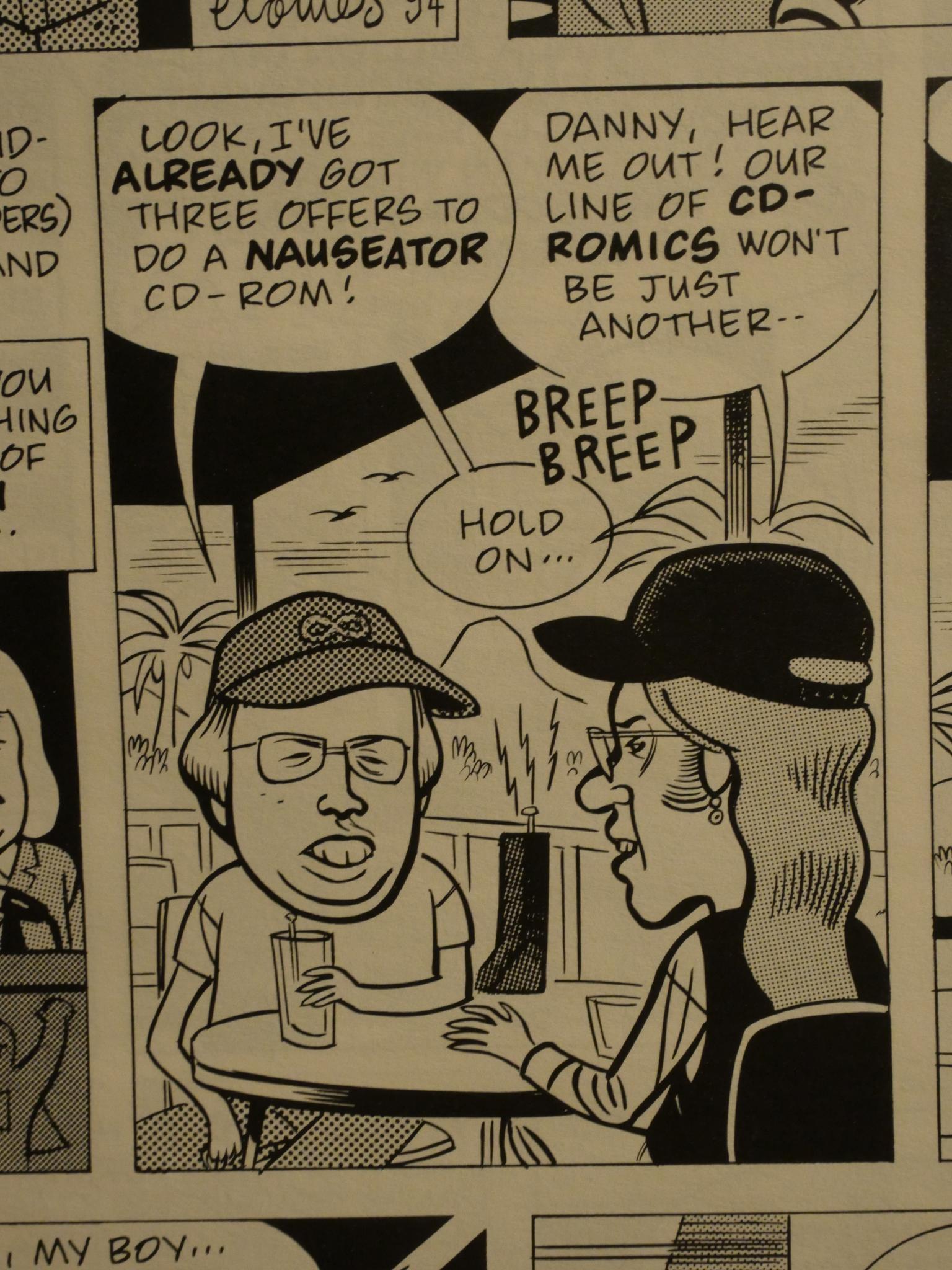
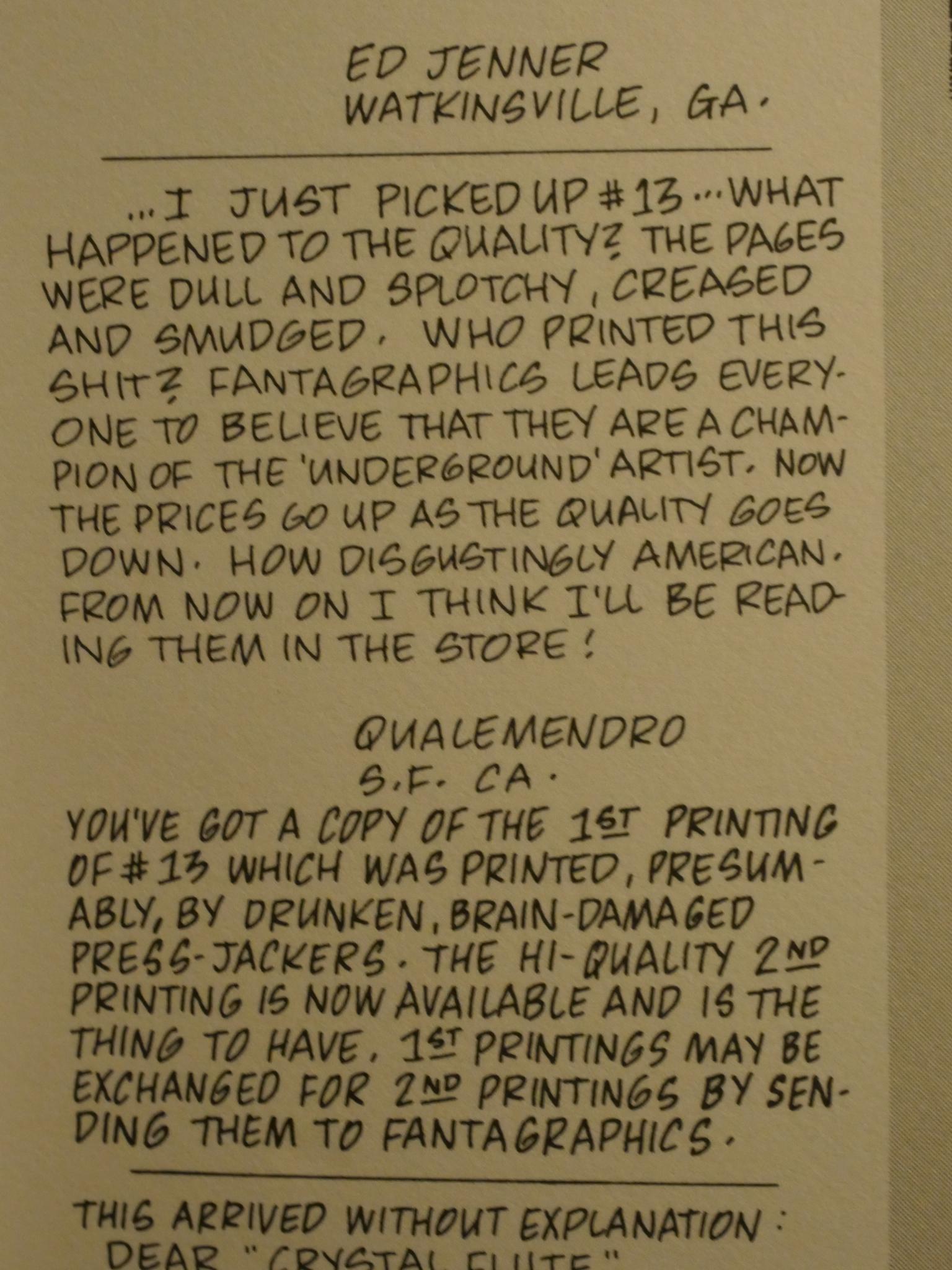
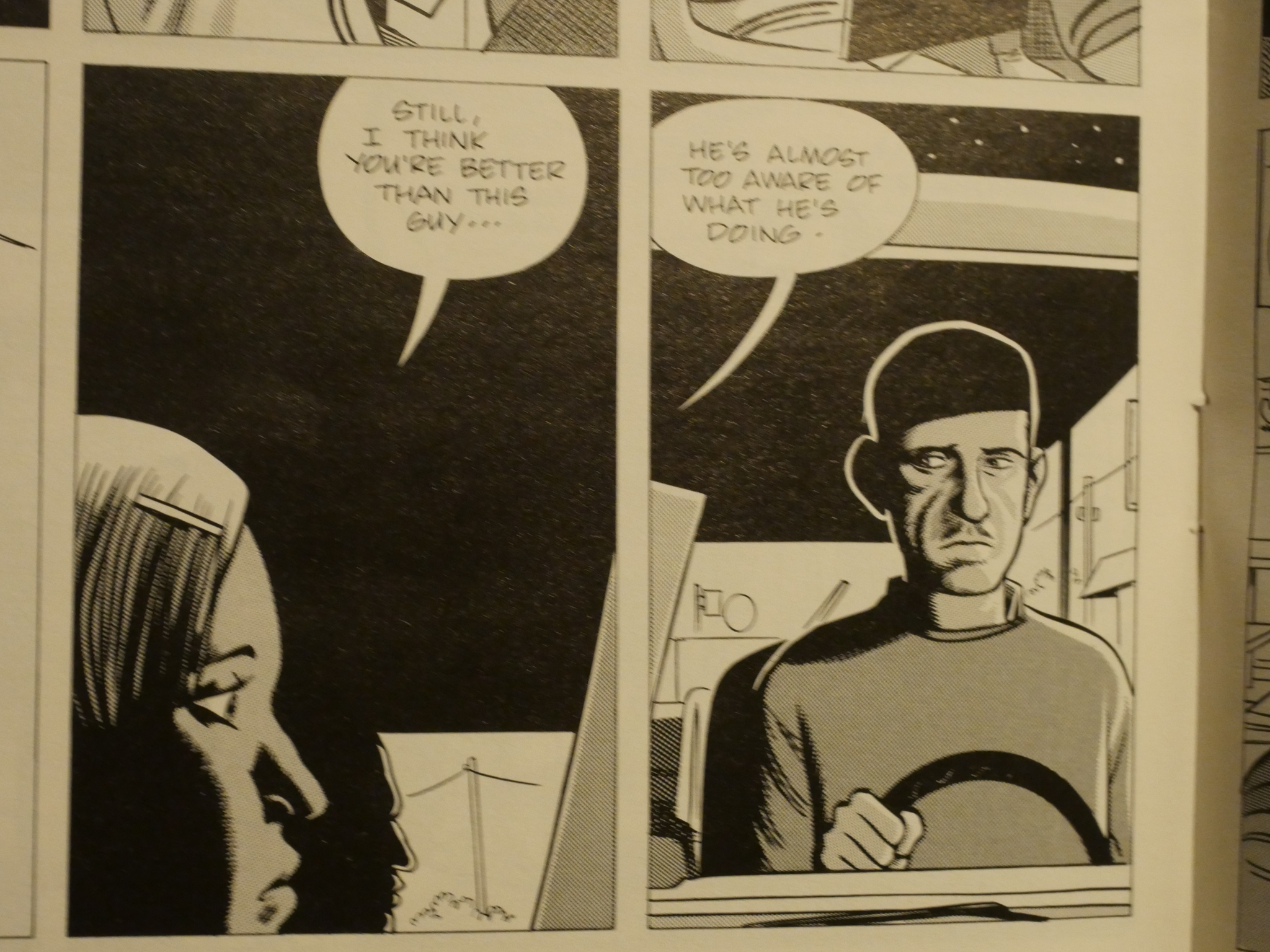
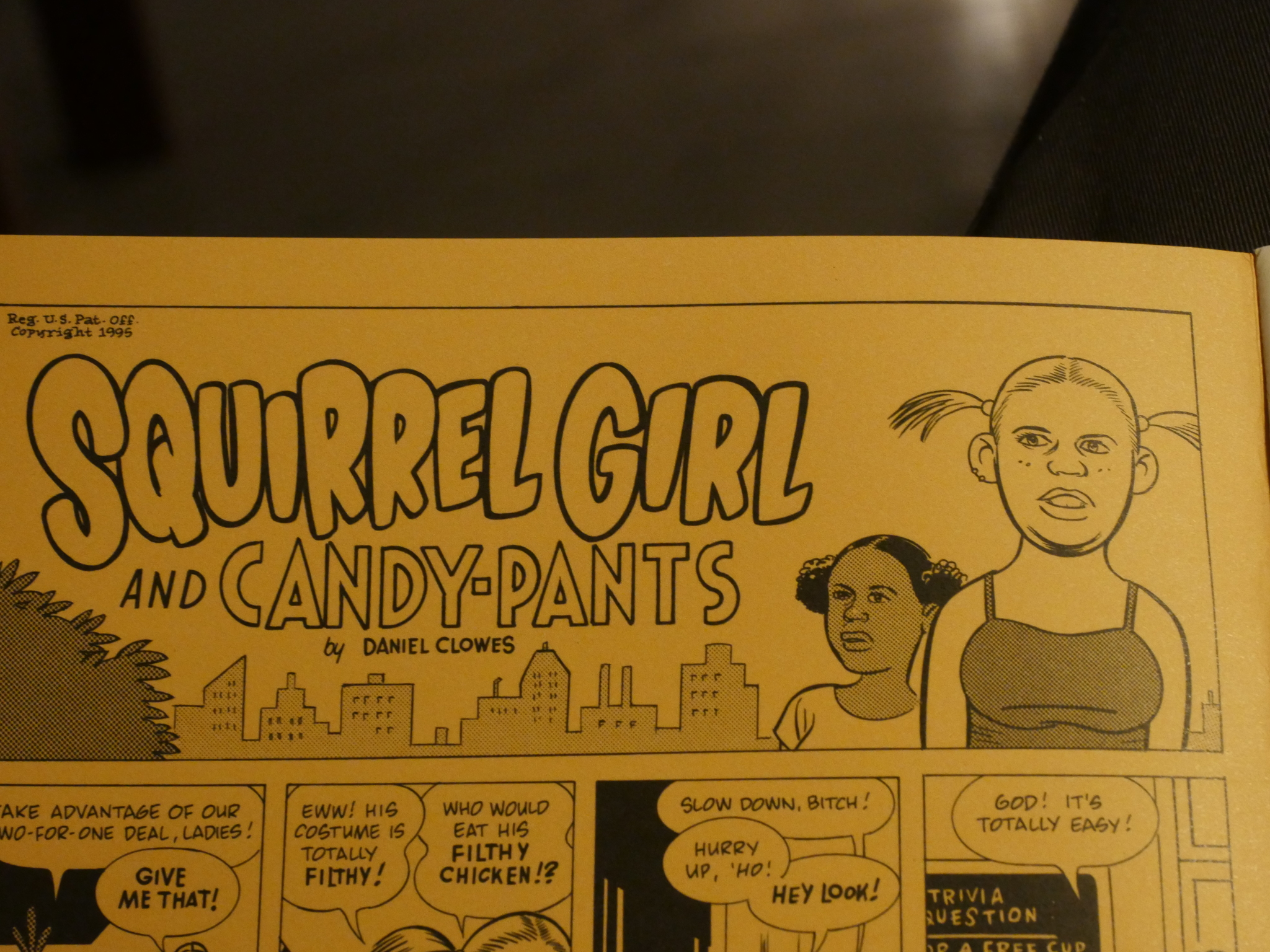
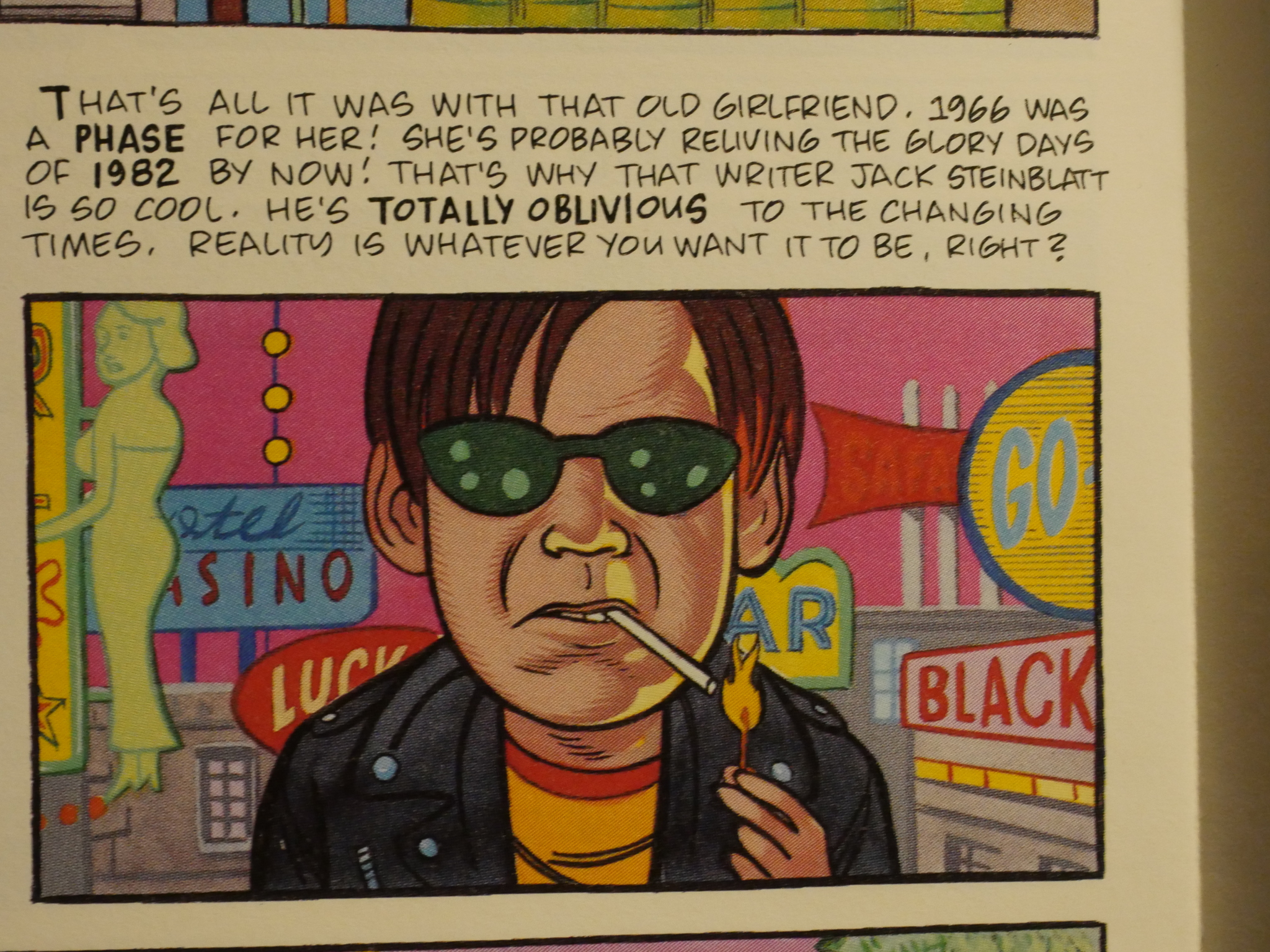
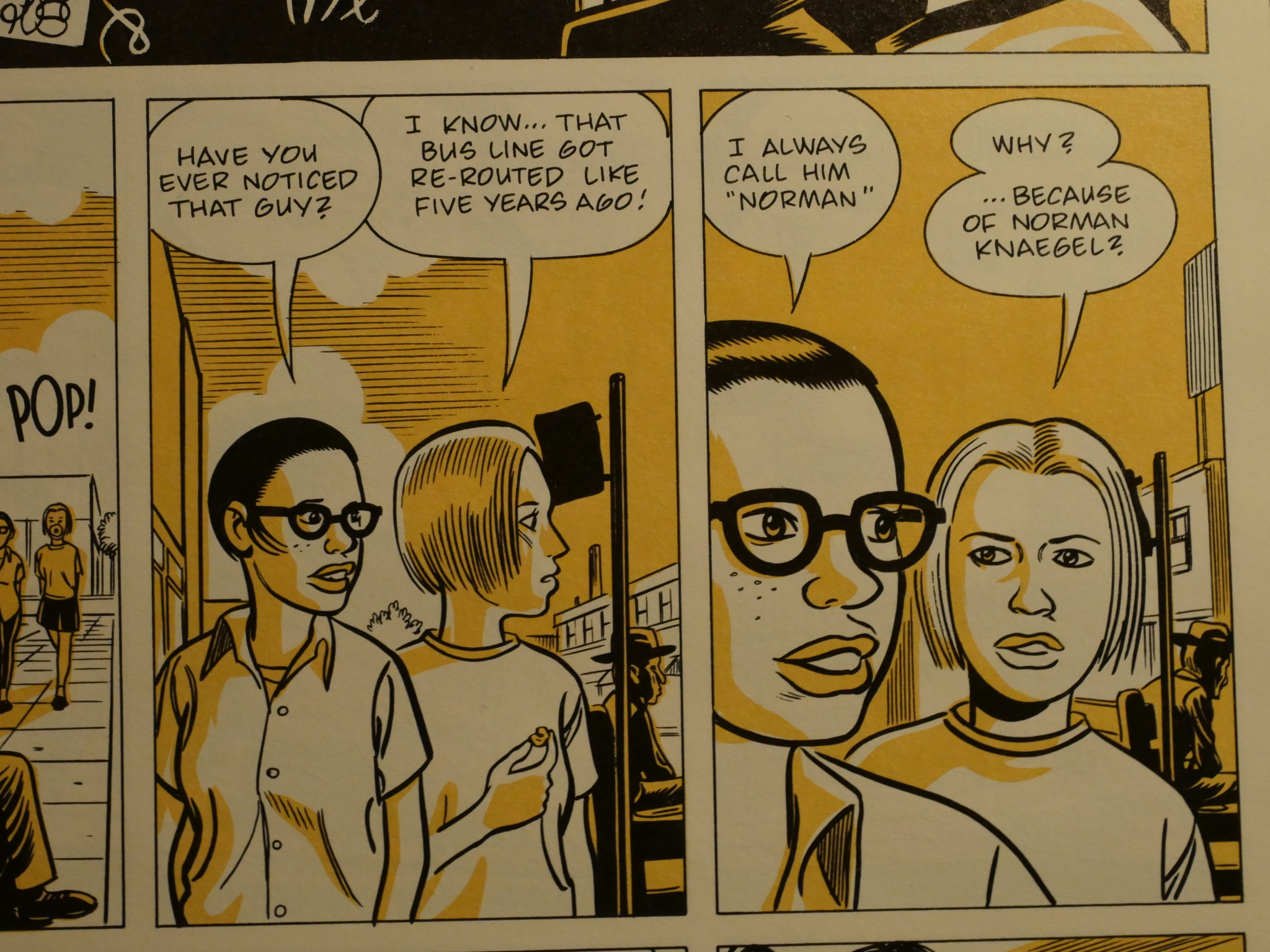
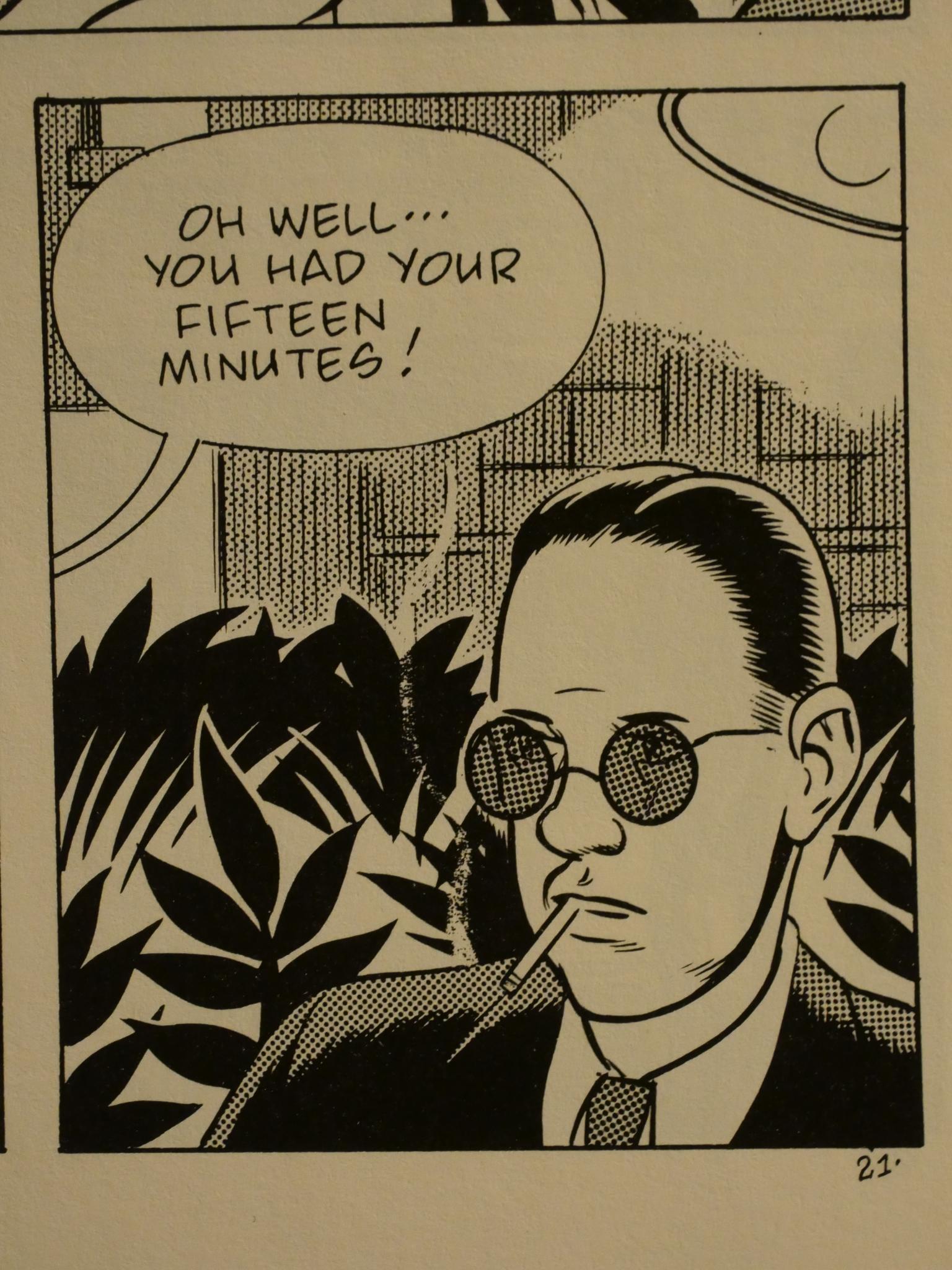
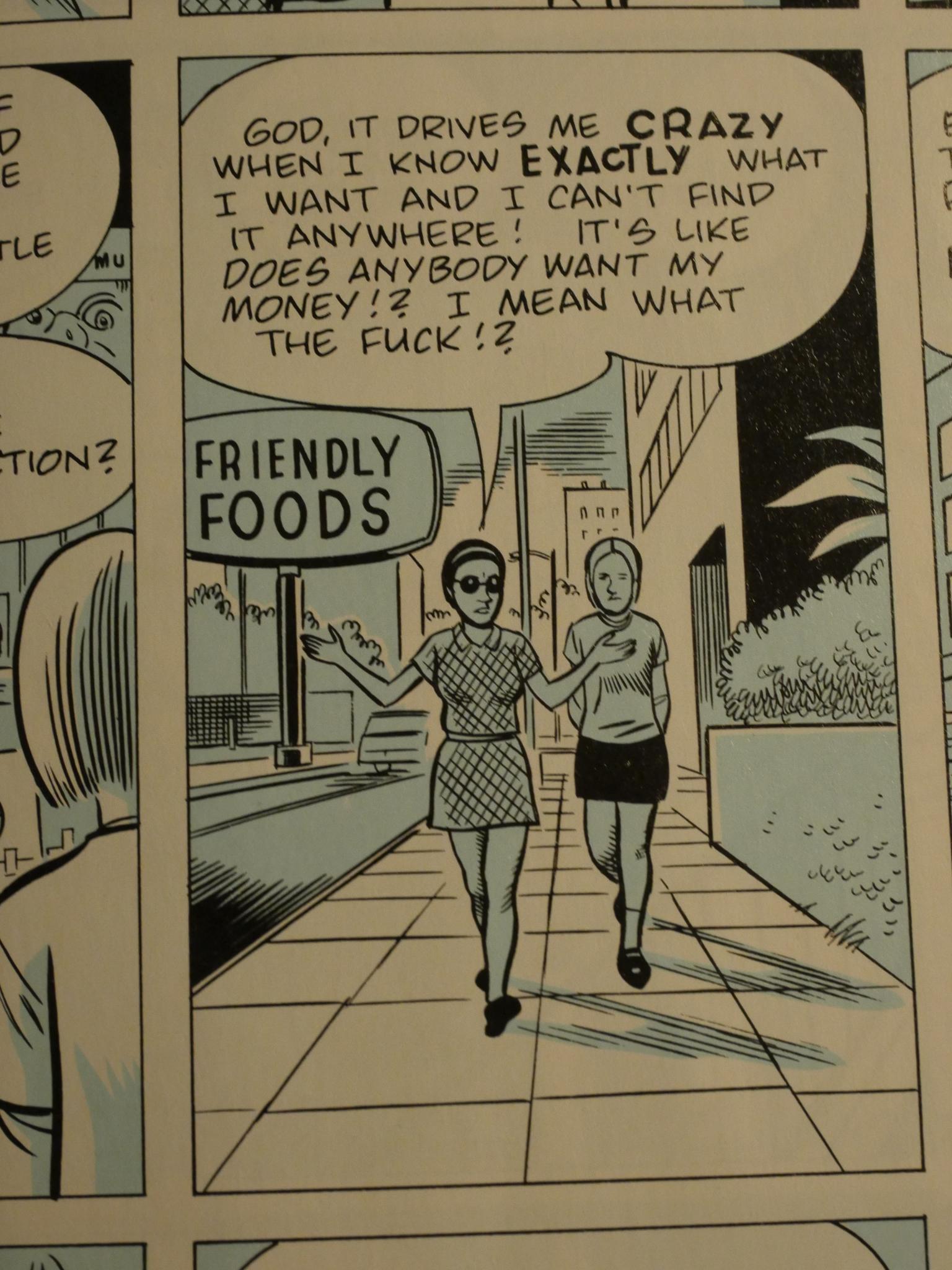
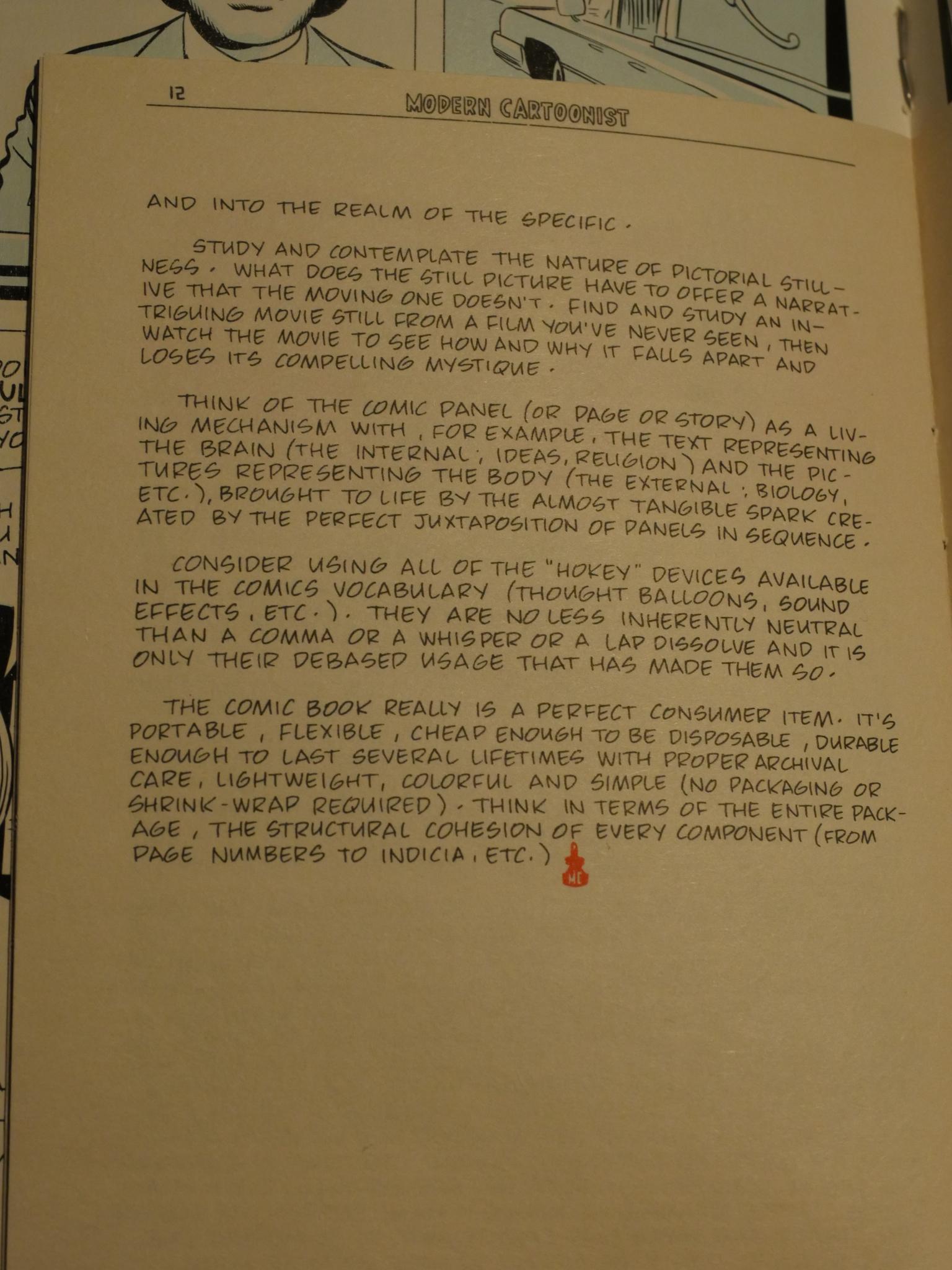
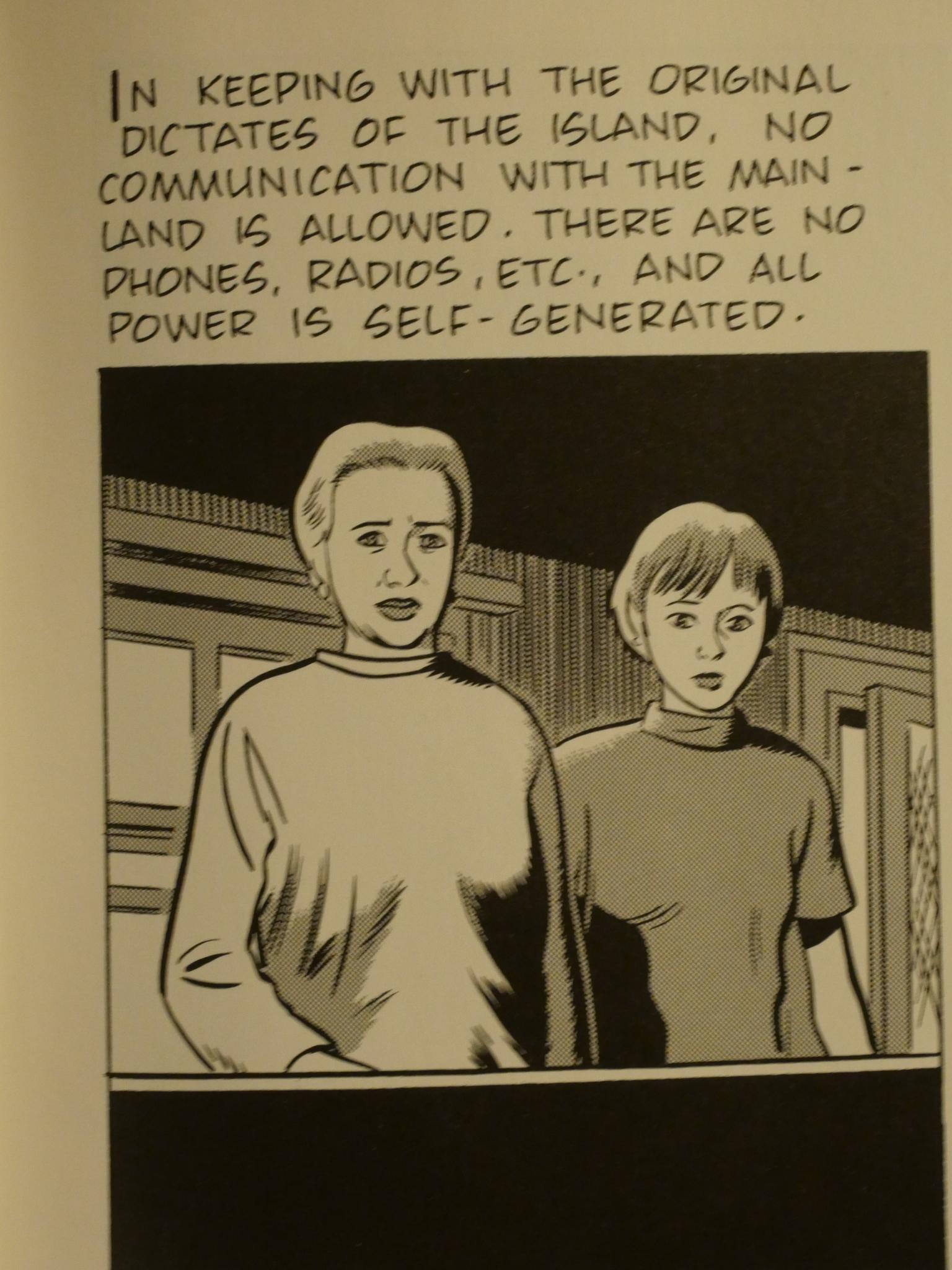
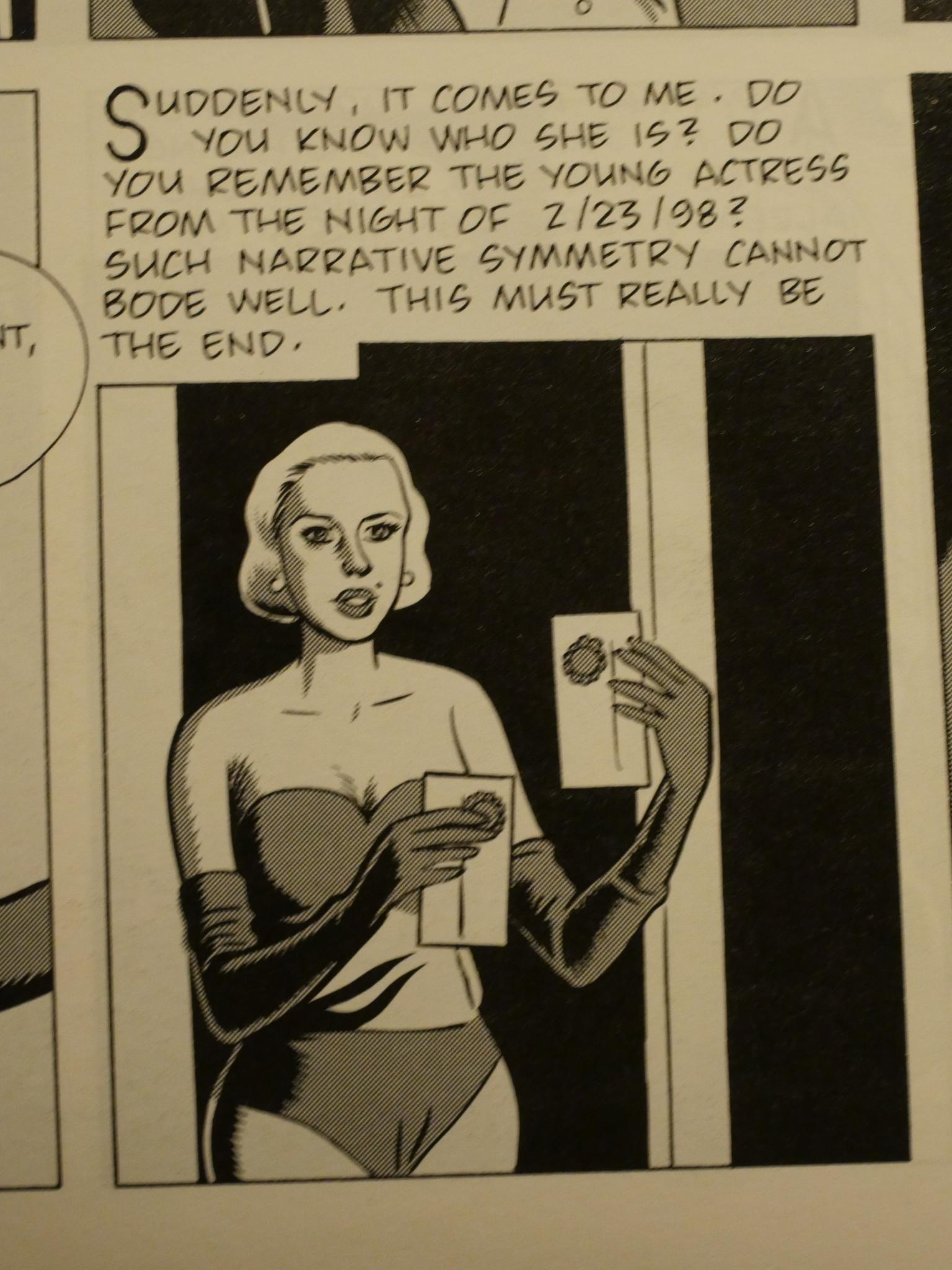
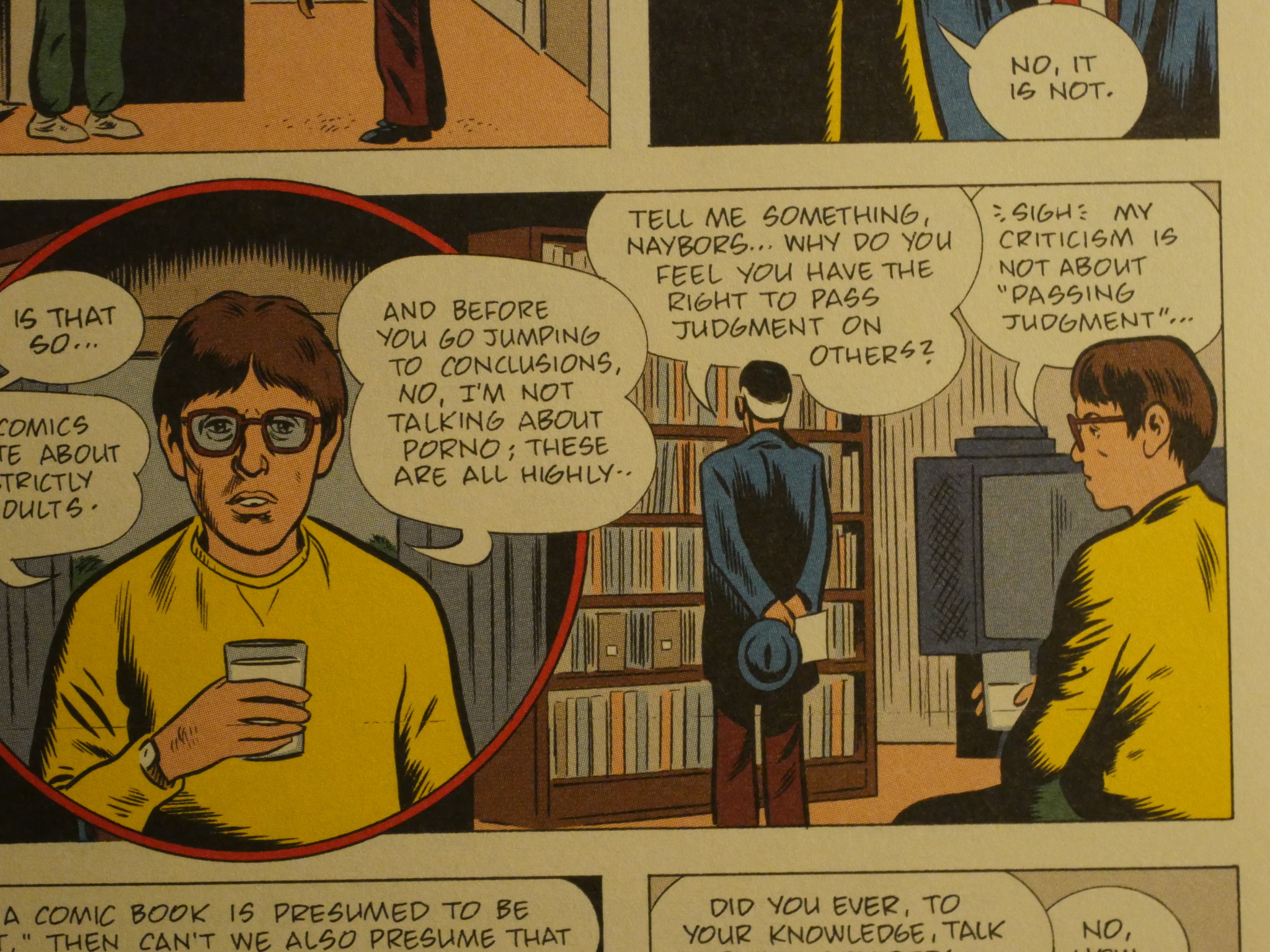
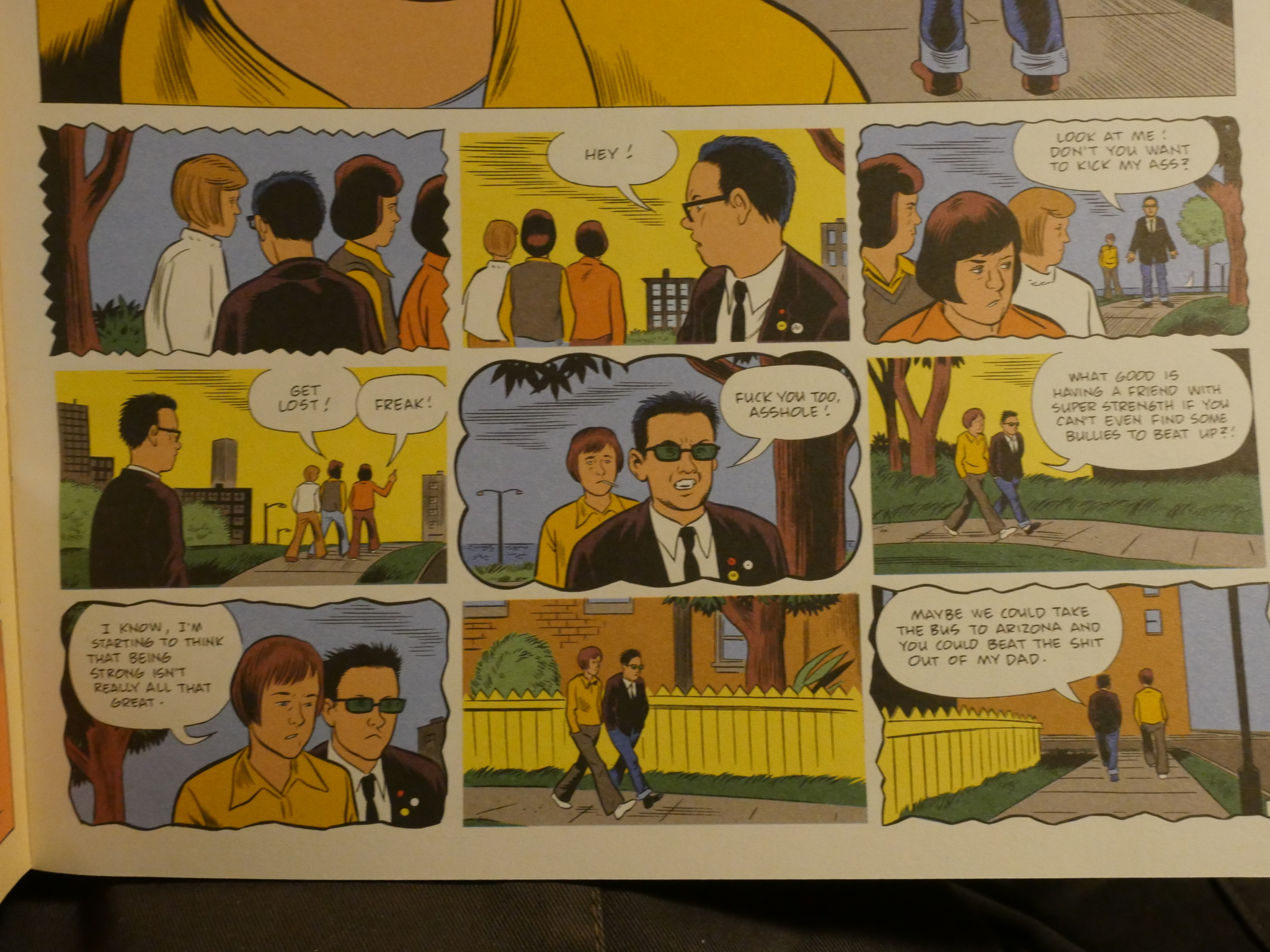
Great post! Lots of fun observations. Well, I am in the camp that enjoyed Patience. The work of Dan Clowes and the actual culture that he lampoons are inextricably linked. There is no getting around that.
Nope, you’re right…Patience was crap
…and the Los bros reference in Pussey is based on a real alternative comics/home improvement crossover incident
This is a comment. I miss the sardonic Clowes. I loved the talking to the camera and the constantly shifting plots of “Like a Velvet Glove.”
Thanks for this post and bringing me back to my cooler, younger self.